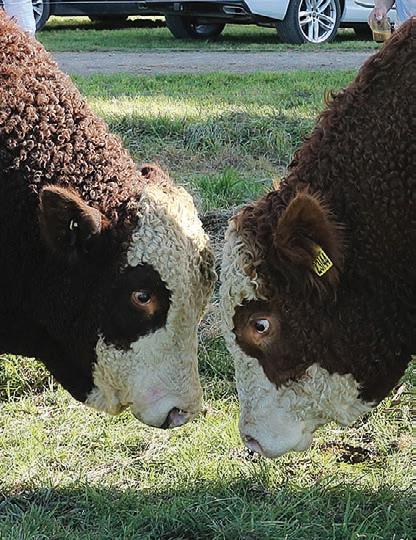

Rumblings of Irish interest in Alliance

THERE is speculation that Irish meat processor
Dawn Meats is one of three entities wanting to invest in the Alliance Group, which is seeking more than $200 million in new capital.
Alliance shareholders will learn the board’s recommendation in the next few weeks. One of the other entities being considered is also believed to be offshore, and the third is said to be from NZ.
Neither Alliance nor Dawn Meats would comment on what they called “market speculation”.
“We will be providing another update to our farmers later this month ahead of a series of road show meetings followed by a formal shareholder vote in the next few months,” said Alliance chair Mark Wynne.
Dawn Meats was established in County Waterford in 1980 by three Irish farming families and annually processes 3.5 million sheep and 1 million cattle, supplied by 30,000 farmers.
The family-owned business operates 10 sites in Ireland and 13 in the United Kingdom, exporting to more than 50 countries, with annual turnover of NZ$4.88 billion.
Meanwhile, predictions made 10 years ago about the meat industry and what would happen to it
unless it restructured have proven remarkably accurate.
The 2015 report, Pathways to Long-Term Sustainability, was written by the ginger group Meat Industry Excellence (MIE), and most of the issues it identified as hindering the industry’s performance back then remain to this day.
They include inefficient procurement, inefficient and poor use of plants, a lack of co-ordinated marketing, a proliferation of competing exporters and an inability to link production to market demands.
Ross Hyland, one of the authors of the report, told Farmers Weekly last week that not only has the meat industry not changed, it also now faces new challenges from forestry and carbon farming.
“That will accelerate the decline.”
And in the meantime restructuring has become even more expensive, he said, noting that it cost Alliance $51 million to close Smithfield last year.
Despite its extensive conclusions and several MIE supporters being elected to the boards of Alliance and Silver Fern Farms, its findings were never implemented.
The report blamed issues arising from inadequate and inconsistent returns for farmers and processors and land use change to dairying for shrinking the industry.
Continued page 3
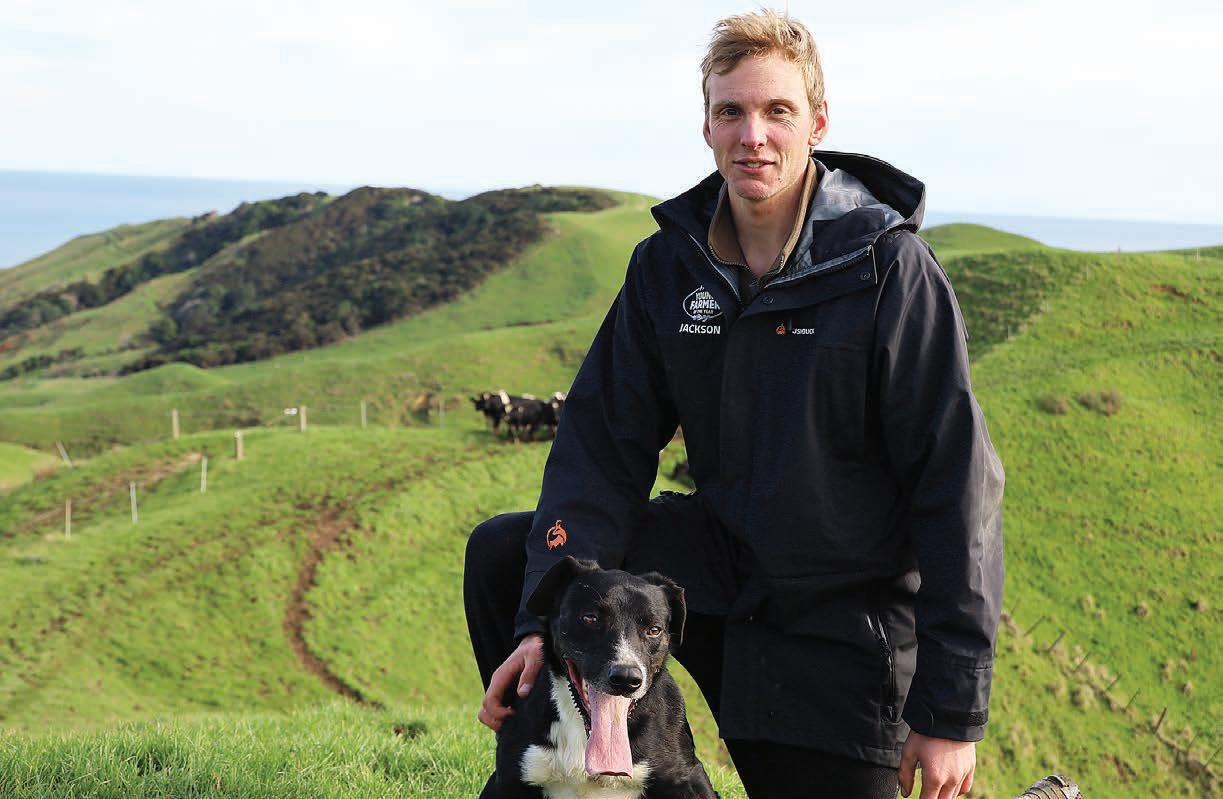
Southern stints help clinch title
Thorough preparation, dedication and having a strong network of contacts helped Hugh Jackson, a sheep and beef farmer from Te Akau, win this year’s FMG Young Farmer of the Year trophy.
Gerald Piddock NEWS 5
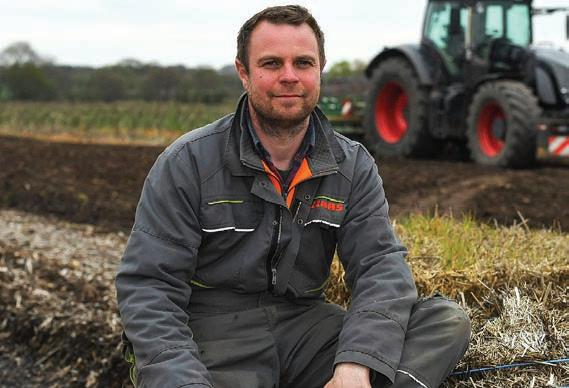
surround GM labelling rules as deadline nears.
YouTube, pet hotels sustain UK farm
Diversification has become a necessity to survive financially for United Kingdom arable farmer and entrepreneur Olly “Blogs” Harrison. ARABLE 14
Caution urged on debit side to biodiversity credits.
7 Ag coaches cut through the clutter, writes Nicole Masters.
OPINION 13
Why



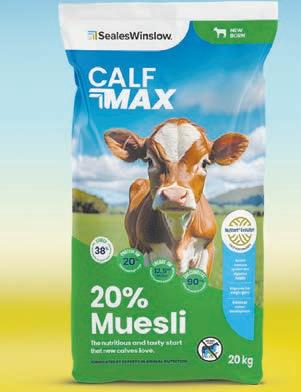

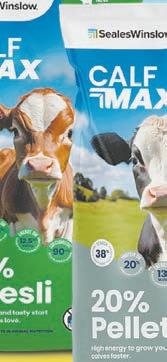


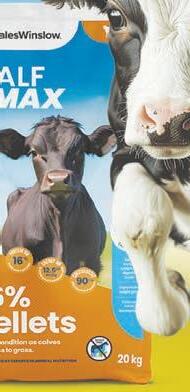
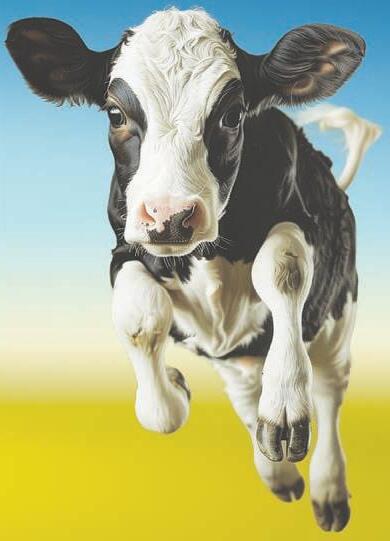


Photo:
Neal Wallace NEWS Production
EDITORIAL
Bryan Gibson | 06 323 1519
Managing Editor
bryan.gibson@agrihq.co.nz
Craig Page | 03 470 2469
Deputy Editor craig.page@agrihq.co.nz
Claire Robertson
Sub-Editor claire.robertson@agrihq.co.nz
Neal Wallace | 03 474 9240
Journalist neal.wallace@agrihq.co.nz
Gerald Piddock | 027 486 8346
Journalist gerald.piddock@agrihq.co.nz
Annette Scott | 021 908 400
Journalist annette.scott@agrihq.co.nz
Hugh Stringleman | 027 474 4003
Journalist hugh.stringleman@agrihq.co.nz
Richard Rennie | 027 475 4256
Journalist richard.rennie@agrihq.co.nz
Nigel Stirling | 021 136 5570
Journalist nigel.g.stirling@gmail.com
PRODUCTION
Lana Kieselbach | 027 739 4295 production@agrihq.co.nz
ADVERTISING MATERIAL
Supply to: adcopy@agrihq.co.nz
SUBSCRIPTIONS & DELIVERY 0800 85 25 80 subs@agrihq.co.nz
PRINTER
Printed by NZME Delivered by Reach Media Ltd
SALES CONTACTS
Andy Whitson | 027 626 2269
Sales & Marketing Manager andy.whitson@agrihq.co.nz
Janine Aish | 027 300 5990
Auckland/Northland Partnership Manager janine.aish@agrihq.co.nz
Jody Anderson | 027 474 6094
Waikato/Bay of Plenty Partnership Manager jody.anderson@agrihq.co.nz
Palak Arora | 027 474 6095
Lower North Island Partnership Manager palak.arora@agrihq.co.nz
Andy Whitson | 027 626 2269
South Island Partnership Manager andy.whitson@agrihq.co.nz
Julie Hill | 027 705 7181
Marketplace Partnership Manager classifieds@agrihq.co.nz
Andrea Mansfield | 027 602 4925
National Livestock Manager livestock@agrihq.co.nz
Real Estate | 0800 85 25 80 realestate@agrihq.co.nz
Word Only Advertising | 0800 85 25 80 Marketplace wordads@agrihq.co.nz
PUBLISHERS
Dean and Cushla Williamson Phone: 027 323 9407 dean.williamson@agrihq.co.nz cushla.williamson@agrihq.co.nz
Farmers Weekly is Published by AgriHQ PO Box 529, Feilding 4740, New Zealand Phone: 0800 85 25 80 Website: www.farmersweekly.co.nz
ISSN 2463-6002 (Print) ISSN 2463-6010 (Online)

News in brief Dairy conference Mallard resigns
Experts from 24 countries will gather in Christchurch this year for the International Precision Dairy Farming Conference. Running from December 3 to 5, the conference will be held in New Zealand for the first time. It is being run by DairyNZ in collaboration with leading research and industry partners. Experts will present on topics such as animal monitoring, sensor technology and data use.
Synlait chief operating officer Paul Mallard has resigned and will leave the company in December.
Mallard has been Synlait’s COO since 2023. He was firstly a director of strategy and corporate affairs before taking on the COO position in June of that year. Prior to that, he spent three years at Fonterra as its general manager of sales and marketing disruption business unit platforms.
DINZ changes
Two new directors and one returning director have been confirmed to the Deer Industry New Zealand board.
Manawatū deer stud breeder and animal scientist Simone Hoskin is the new director appointed by producers, while the new processor-appointed director is Rob Kidd, general manager of Duncan NZ. South Canterbury deer farmer Hamish Fraser has returned to the board as a producerappointed director.
Roper new chair
Guy Roper has been appointed chair of the Dairy Companies Association of New Zealand.
Roper was chief executive of Port Taranaki for six years up until 2021, playing a role in the supply chain that enables New Zealand’s dairy exports. Before this, he held a variety of roles in the dairy sector, including working at Fonterra, as a global account director for Nestlé and as its commercial director of global trade and ingredients.

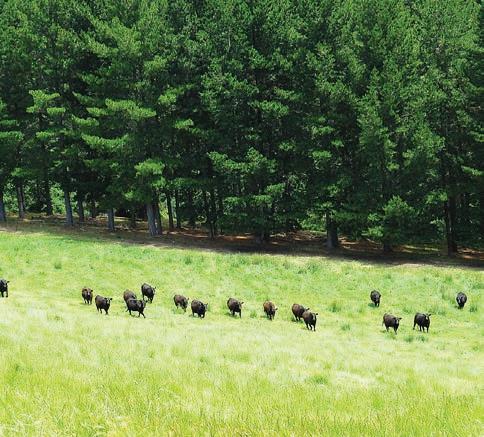
NOT ENOUGH:
While BLNZ and the MIA support the government’s intentions behind proposed legislation to tighten the criteria for farmland to forestry conversions, they argue it needs to go further if it is to make meaningful change.
Govt urged to close ETS loopholes
Staff reporter NEWS
Sheep and beef
RED meat sector groups are urging the government to go further in proposed changes to the Emissions Trading Scheme to prevent ongoing conversions of sheep and beef farmland into carbon farms.
Proposed legislation needs to be strengthened if it is to stop these conversions, Beef + Lamb New Zealand (BLNZ) and the Meat Industry Association (MIA) said in a joint submission to the Environment Select Committee to the Climate Change Response (Emissions Trading Scheme – Forestry Conversion) Amendment Bill.
The two groups have proposed tightening the criteria for temporary exemptions that currently allow land converted after December 4 2024 to enter the ETS.
The Bill aims at restricting wholesale conversions of farmland to exotic forestry by stopping Land Use Classification 1-5 land from entering the ETS and capping new ETS registrations on LUC 6 land.
BLNZ and the MIA also want the government to extend the proposed moratorium on wholefarm conversions to all land classes, not just LUC 1-5.
While it is a step in the right direction, the changes proposed by BLNZ and MIA are essential if the legislation is to have real
Continued from page 1
It identified excess processing capacity, inefficient and ageing plants and technology, excessive investment in procurement relative to marketing and insufficient investment in marketing.
“It all comes down to bums on seats or, in the meat industry, lambs on hooks,” said Hyland.
The cost of these inefficiencies to the industry in 2015 was calculated at $450m. They were not being addressed due to too many competing processing and marketing companies, a lack of processor profitability and farmers not committing to supply specific processors, the MIE report said.
It calculated there were about 70 red meat exporters operating at that time.
The industry is still struggling
Funds poured into Opuha Dam upgrades

THE government’s Regional Infrastructure Fund support for vital upgrades to the Opuha Dam and irrigation scheme is set to safeguard South Canterbury’s water future.
impact, BLNZ chair Kate Acland said.
“The government needs to tighten the temporary exemptions that allow land converted after 4 December 2024 to enter the ETS. The criteria are too broad and open to abuse.
“It’s also critical the moratorium is extended beyond what is currently proposed. Current restrictions only apply to land classes 1-5, yet we know 89% of whole-farm conversions to date have occurred on land classes 6-8.
“LUC 6, in particular, is highly productive and vital to the sector.”
Farms should not be sacrificed to plug ETS loopholes for fossil fuel emitters. The proposals do not stop forestry establishment for harvesting, they simply stop the ETS from distorting land use decisions, she said.
New Zealand is the only country in the world, aside from Kazakhstan, that places no restrictions on the use of forestry offsets in its ETS, Acland said.
“Since 2017, at least 300,000 hectares of whole sheep and beef farms have been sold to forestry interests. We estimate a further 50,000ha will be added before the new rules take effect.
Without stronger controls, we could see a million hectares lost by 2050. This is unsustainable for our sector, our rural communities, and the country.
MORE: See page 8
with excess capacity, falling sheep numbers, companies paying above market rates to attract stock and a lack of profitability, but this time it is happening with even fewer sheep to process.
There were 20.6 million lambs processed in the 2014-15 season and 17 million in the 2024-25 season.
The MIE report offered solutions such as the collective closing of plants to consolidate capacity, a moratorium on new capacity, farmers committing to long-term supply contracts and the industry collectively having reserve capacity for times of drought.
The most recent closures were SFF Fairton near Ashburton in 2017, and last December Alliance closed Smithfield at Timaru.
The MIE report calculated eight facilities were closed between 2005 and 2012, which reduced the
More than $56 million is being invested into three water resilience projects in rural Canterbury, through loan facilities.
Opuha Water Ltd (OWL) chief executive Bjorn Triplow said the government investment will ensure the dam and water delivery infrastructure continues to serve the region effectively for generations to come.
Regional Development
Minister Shane Jones said the ease of access to water is a top priority for Canterbury’s rural communities.
The projects are:
• Opuha Dam and Irrigation Scheme upgrade: up to $20.8m to upgrade Opuha Dam.
• Balmoral Water Storage Facility (Amuri): up to $20m to build a pond to store up to 10 million cu m for an existing irrigation scheme where resource consents are already held to divert, take, use and discharge water to land in Amuri Basin.
• Waimakariri Irrigation Scheme: up to $15.6m to develop a large-scale storage facility to improve water reliability through the existing Waimakariri Irrigation Scheme. Triplow said the enhancement will extend the Opuha Dam’s operational lifespan and strengthen its resilience against climate change and extreme weather events. The work will improve the dam’s protection against erosion, floods, and earthquake damage.
It also aims to optimise water storage management
weekly sheep killing capacity by 138,690.
Between 2004 and 2013, the building of new plants or the purchase of existing works added to or maintained weekly killing capacity of 100,000 sheep.
A survey of farmers that accompanied the MIE report found more than 75% agreed that a Fonterra-type co-operative ownership model could work for the red meat industry.
Almost 60% believed that this structure would enable producers to gain a larger share of the value chain and thus increase their returns.
Last week voters were evenly split in a poll in Farmers Weekly that asked whether meat companies are better off being farmer-owned. A tick over 50% thought it didn’t matter and 49.8% said it was important.
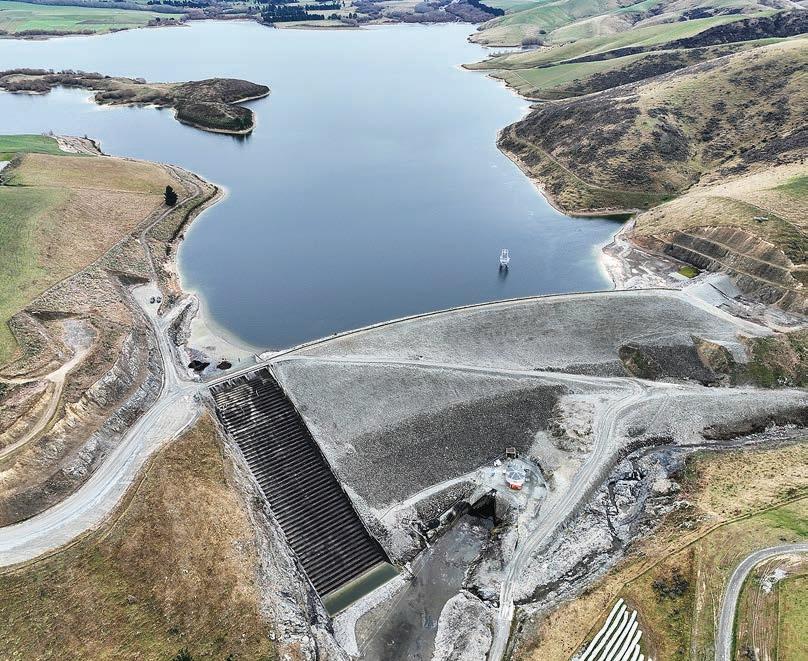
net economic benefit of $315m to the South Canterbury region.
Beyond its role in supporting sustainable farming, the dam has catalysed growth in downstream industries.
and strengthen the system’s emergency response capabilities.
A key objective of Opuha’s strategic capital programme is the renewal of critical resource consents due in 2030.
Significant investments in infrastructure and environmental initiatives are already underway, positioning OWL favourably for these upcoming engagements.
“We welcome the government’s recognition that the Opuha Water’s infrastructure is a cornerstone of South Canterbury’s economic prosperity.
“Beyond its role in supporting sustainable farming, the dam has catalysed growth in downstream industries, delivering an annual
“It also plays a crucial role in preserving the health of the in-river environment, balancing productivity with ecological care.”
The dam was originally constructed in the late 1990s, in response to devastating droughts, in a community-led initiative designed to safeguard local livelihoods and to retain a viable environmental flow of water in the Opihi River, protecting a vital recreation, cultural and water supply resource.
The government’s support will contribute toward a major infrastructure enhancement programme planned by Opuha Water with projects designed to improve dam safety, manage flood passage, and enhance the reliability of water for the Opihi River and the community.
Crucially, the dam also manages flood passage, acting as a flood buffer to safeguard communities, and infrastructure from extreme weather events, such as those experienced in 2021.
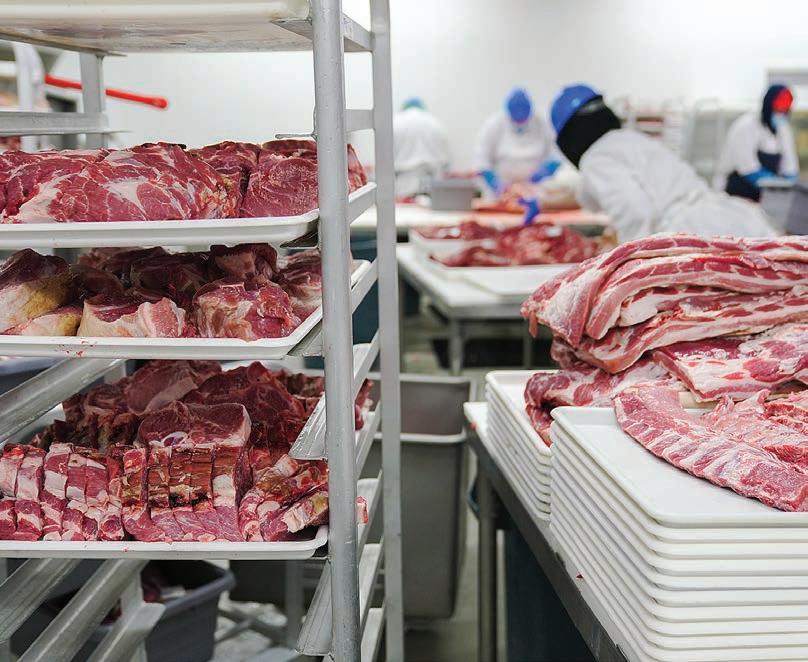
LOSS FORETOLD: In 2015 the group Meat Industry Excellence warned that the red meat industry would be in trouble if it
Annette Scott NEWS Water
SECURITY: The Opuha Dam will received an upgrade at a cost of up to $20.8 million.
Photo: Opuha Water Ltd
Bjorn Triplow Opuha Water Ltd
Questions surround GM food labelling rules

Gerhard Uys NEWS Food and fibre
NEW Zealand and Australian food ministers have a month to decide whether to adopt changes to the definition of genetically modified food, but questions remain over how new rules will affect labelling and who will be responsible for enforcement.
In June the Food Standards Australia New Zealand (FSANZ) board approved Proposal P1055 to update definitions for genetically modified (GM) food in the Food Standards Code.
The proposal will clarify which foods require pre-market assessment, approval and GM labelling.
A FSANZ spokesperson told Farmer’s Weekly: “FSANZ has proposed that some genomeedited foods should not be regulated as GM foods because they are identical to conventional foods already in the food supply and pose the same low risk. If adopted, the updated definition would mean these foods will not require GM labelling under the code.”
The spokesperson said food ministers from New Zealand and Australia had 60 days to consider
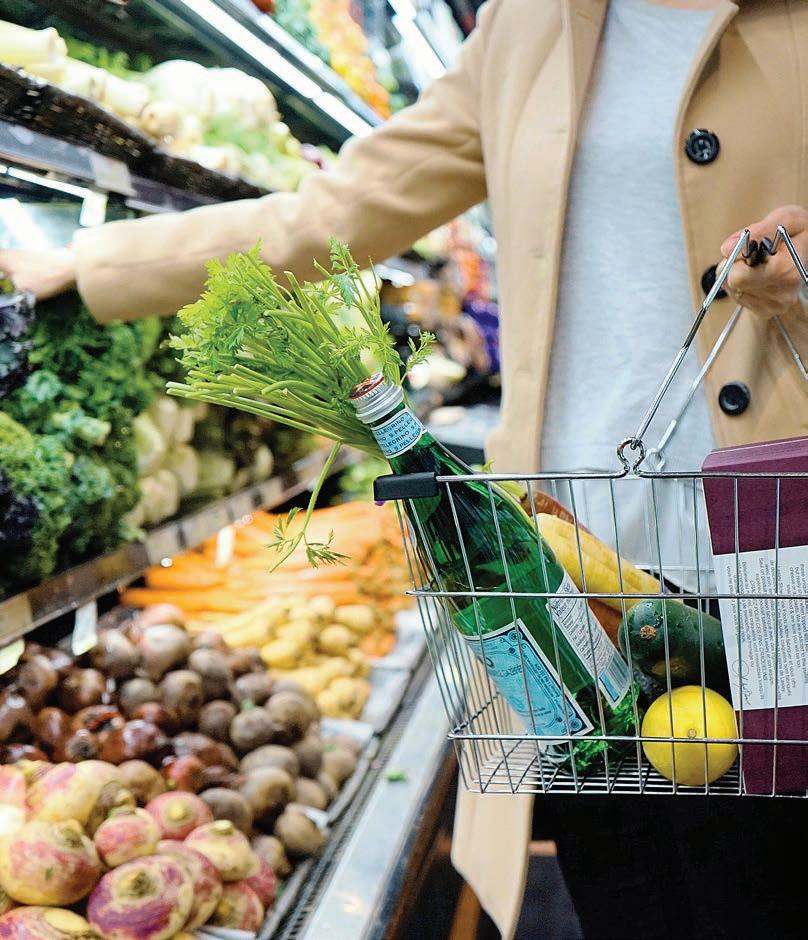
FSANZ’s decision, made on June 4. However, it is not in the scope of the proposal to review the current approach to GM labelling, he said.
“Protecting
intellectual property and managing supply chain integrity are outside FSANZ’s regulatory remit.”
Among other agencies, the Ministry for Primary Industries and the Department of Agriculture are involved in intellectual property protection and supply chain integrity.
Andrew Hoggard, Minister for Food Safety and the Associate Minister of Agriculture, did not respond to queries from Farmers Weekly on the topic.
New Zealand Food Safety deputy director-general Vincent Arbuckle said it is proposed that new breeding techniques that do not introduce new, or novel, DNA are broadly equivalent to conventional breeding, so foods made using these techniques will not be required to be labelled as genetically modified.
Under the proposal, food will continue to be required to be GM labelled if it contains novel DNA or novel protein or altered characteristics, and is therefore different to non-GM food, he said.
He suggested Farmers Weekly contact FSANZ about labelling.
The Commerce Commission is the primary agency enforcing the Fair Trading Act.
Vanessa Horne, general manager, competition, fair trading and credit at the commission, said consumers have the right to accurate information about products and services.
It is very difficult for consumers to verify claims made by businesses, so businesses must ensure references made on food packaging are clear and not misleading, Horne said.
Brendan Hoare, GE spokesperson for Organics Aotearoa NZ, said the rule change will allow GM foods created using new gene editing methods to enter the food system without labelling or traceability. Testing for GMOs in food would fall on the producers or merchants, at a cost, he said.
“New Zealanders deserve the right to know what’s in their food.”


you think all food products should state on the label whether they have been genetically modified?





















GUESSWORK: Consumers may not know if food contains gene-edited ingredients if a new rule redefining genetic modification is adopted, lobby groups say.
Photo: Pexels
Southern stints help Northerner clinch title

THOROUGH preparation, dedication and having a strong network of contacts helped Hugh Jackson win this year’s FMG Young Farmer of the Year trophy.
The 27-year-old sheep and beef farmer from Te Akau won the contest representing the WaikatoBay of Plenty region after three days of competing in the Grand Final in Invercargill, ending on July 5.
After a few restless nights from the adrenaline still buzzing, he said winning the contest has started to sink in.
“It’s pretty cool to realise that you have always won the competition and no one can take that away from you.
“It’s exciting to have ticked that goal off and I’m looking forward to the year ahead and the opportunities it presents,” he said. He is taking the publicity that
comes with winning the contest in his stride, seeing it as a way of promoting both the primary sector and Young Farmers, which he is heavily involved in.
Jackson chairs the Hamilton City Young Farmers Club and last year helped with the regionals and Grand Final when the contest came to Hamilton.
He credits his previous employment in the dairy industry and time spent living in Southland as critical to his win because it broadened his skill set and he was used to the region’s farming style.
Jackson studied agri-commerce at Massey University after leaving school and shifted to Invercargill for a year after graduating as part of DairyNZ’s then-graduate programme.
He then moved to Ashburton, working for DairyNZ as part of its regional team for a year, before returning to Southland where he worked for sharemilkers (now farm owners) Sam and Jenna Hodsell.
He qualified for the 2023 Young Farmer of the Year Grand Final,
representing Otago-Southland, and finished third.
He returned home just before competing in that and has remained in Waikato since.
He is the fourth generation to work his family’s hill country sheep and beef farm after his great grandfather bought the original 600 acres in 1947 when he returned from World War II.
Today, including a block of land they lease, the farm is 1950ha in total. They run Friesian bulls, buying the stock in as yearlings to18 months old and finishing them when they reach around two and a half years.
They also run 2500-odd breeding ewes that are mated to a terminal sire.
Finishing third in 2023 taught Jackson some valuable lessons that he took on board in preparing for this year’s contest.
He met and maintained contact with lots of people during his time in Southland and used that network to help him prepare.
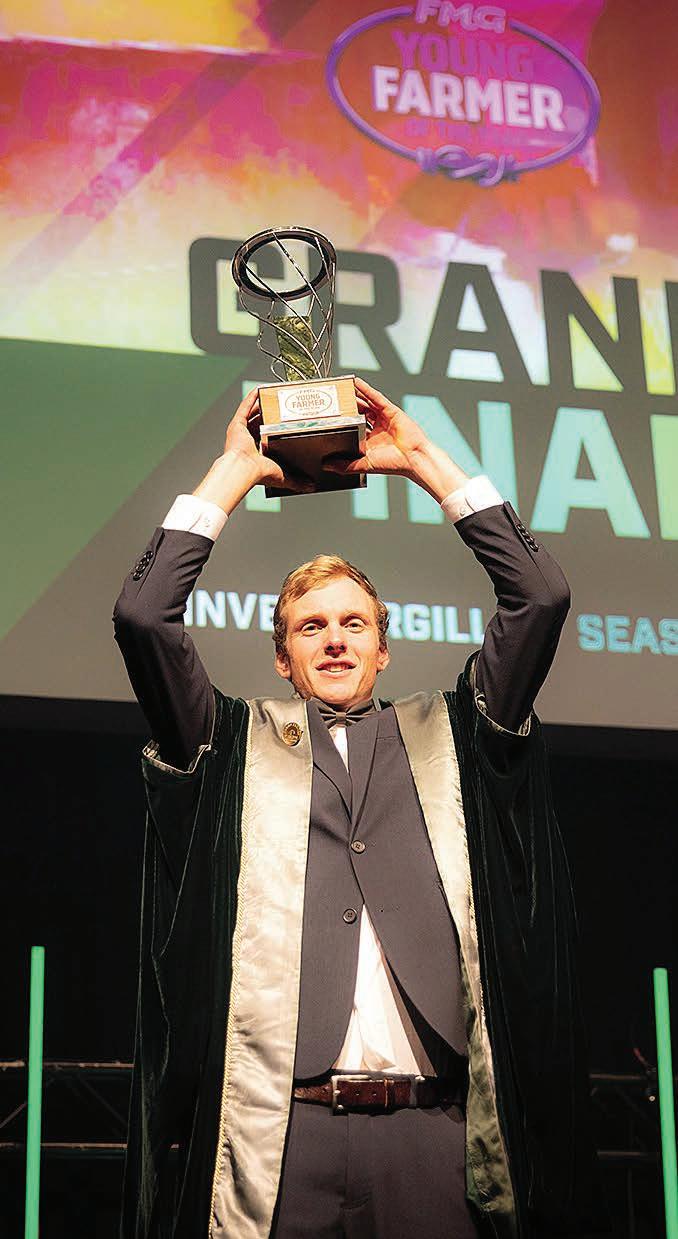
PROMOTION: Hugh Jackson is taking the publicity that comes with winning the FMG Young Farmer of the Year contest in his stride, seeing it as a way of promoting both the primary sector and Young Farmers.
SAFARI: 2025 FMG Young Farmer of the Year winner
Hugh Jackson will take a longplanned two-week holiday in Tanzania before returning to the farm at Te Akau.
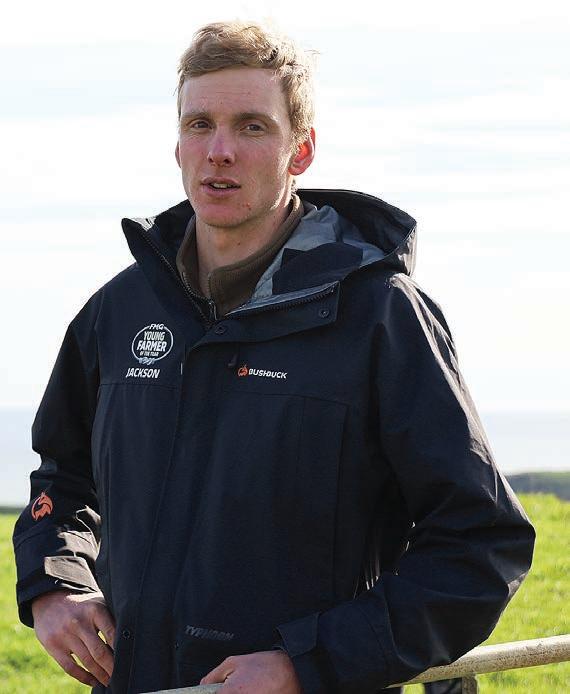
One was Jolene Germann, who organised a mock technical day that mirrored that part of the contest.
This included an interview, HR challenge, exam and preparing for the innovation project, which includes presenting a business case to a panel of judges in a written and oral format.
Other contacts included 2023 winner Emma Poole and her husband Chris, who he became good friends with after meeting them in the 2023 competition.
Jackson said he would not have won without these people, along with the wider support network of friends and family that helped him prepare.
“I really want to thank them for the support and for everyone who has helped me prepare for those two grand finals.”
While he has yet to read the final tally of points, he strongly suspects that the preparation and the practice run he did helped him score highly in the technical sections of the contest.
I’ll be parking up here for the long term to see what we can do with our special bit of family history.
Hugh Jackson 2025 FMG Young Farmer of the Year
It also allowed him to devote more time to the less-predictable practical day of the contest, where the contestants do not know in advance what skills they have to show.
At the end of that day, he said, he was reasonably confident heading into the quiz night.
“I thought I had completed a fairly solid couple of days. I didn’t feel like I had come across anything that I completely had no idea what to do.”
His preparation paid off as he won the community footprint module, the agri-business challenge and agri-sports section.
But he also thought the contest would be a lot closer than it ended up being. In the end, 68 points separated him from runner-up Gareth McKerchar.
Looking ahead, Jackson will take a long-planned two-week holiday in Tanzania before returning to the farm.
“I’ll be parking up here for the long term to see what we can do with our special bit of family history and how we can improve its financial and environmental outcomes and keep pushing forward.”
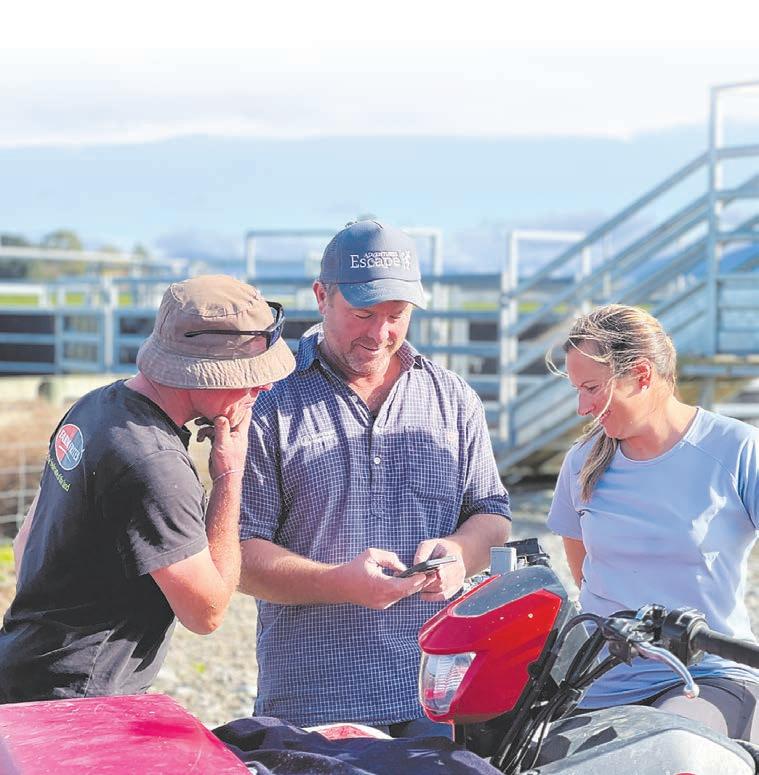
Gerald Piddock PEOPLE Skills
Photo: Gerald Piddock


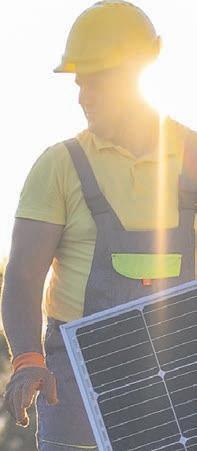


Beware debit side of biodiversity credits

Richard Rennie NEWS Environment
AS APPEALING as biodiversity credits may be to generate more conservation revenue, an environmental expert cautions that pitfalls and problems remain, demanding attention to ensure markets can be enduring and successful.
In June, Associate Minister for the Environment Andrew Hoggard announced the government would endorse nine existing pilot projects across New Zealand to build greater understanding of how such credits may work. He said such a scheme would help meet demand from international and domestic investors seeking high quality nature and carbon credits to meet global standards.
Marie Doole is an environmental researcher based in Masterton. As the author of a recent analysis on community conservation funding, she appreciates the funding challenges conservation efforts are facing.
She said much remains to be understood about how a scheme could operate.
She fears it also risks becoming a diversion as public conservation funds continue to be screwed
down or eliminated altogether.
Funds cancelled in the past year included the long-running Nature Heritage Fund, the Crown Land Acquisition Fund, and the Kura Taiao Fund, while the Department of Conservation’s Community Fund is also due for cuts.
“Outwardly, voluntary biodiversity credits look good.
“They align with protecting private land, providing longrunning funding sources for community conservation and giving people a reason to safeguard nature,” Doole said.
She noted many people are ardent enthusiasts about the concept.
“It’s good to be optimistic, but let’s not let our brains fall out. There are good reasons to be cautious.”
Doole said she is not strongly for or against credits, but maintains they are not silver bullets given their complexity. They sit within a bigger picture that needs attention, including from the government.
“Global experience demonstrates that there is a symbiosis between government funding and private-philanthropic funding –you can’t have one without the other.”
She said the nature credits concept is one option but there are a range of others, like payments
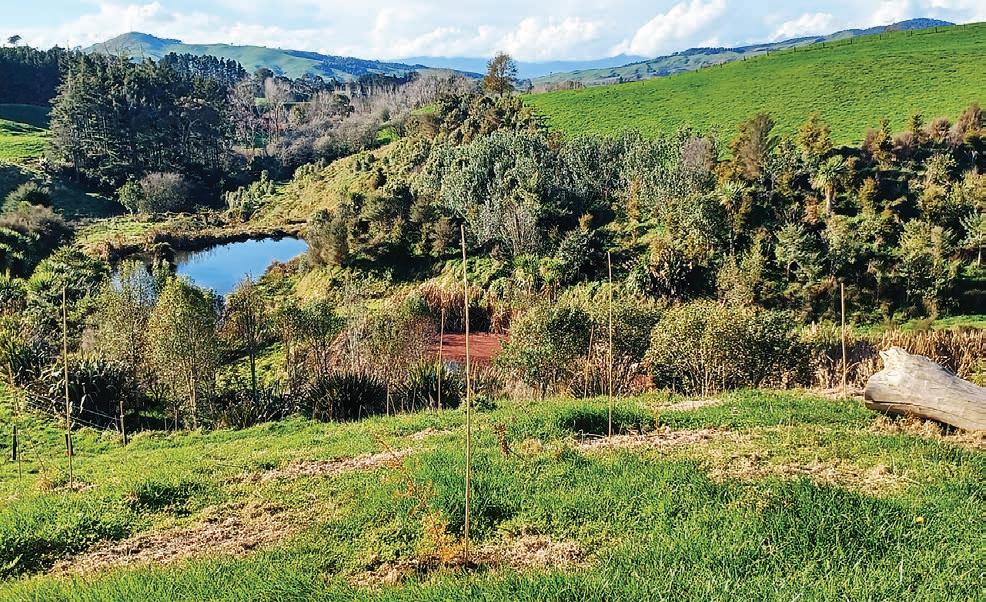
for ecosystem services, or even a land use intensity tax.
She acknowledged the good work being done by the nine pilot projects selected to be studied for a credit system.
They include the high-profile Sanctuary Mountain project near Cambridge, and Southland’s Waituna nature credits prototype.
“We will learn lots from that range of projects. It will be interesting to see how they are evaluated, by whom and what lessons are extracted and carried forward.
“Nature can’t wait, we know there’s urgent need out there and
the slew of recent cuts haven’t helped at all.”
The QEII Trust has been hit hard by funding cuts since Jobs for Nature ended.
Despite recently re-securing $4.5 million over three years, CEO Dan Coup said the group will be barely able to get half its usual covenant applicants over the line.
The trust has in the past been mooted as a possible manager of biodiversity credits. But Coup, too, said there is much more to understand about how they would operate.
“There are questions there on what would be eligible. Equality is
CHALLENGED: Marie Doole says biodiversity credits at best may be one option to include in a portfolio of environmental solutions, and at worst are a diversion from ever-shrinking government environmental expenditure that landowners may have benefited from.
an issue. For example, is saving a kākāpō habitat down south equal to re-planting a hillside up north in native bush?”
He also questioned how many corporations are genuinely in the market seeking such credits. This contrasts with something like carbon credits, where companies are often legally required to account for and offset or reduce their carbon emissions.
He said Australia’s credit system is more advanced than New Zealand’s – but it has also had “substantial” amounts of government funding invested alongside the scheme.
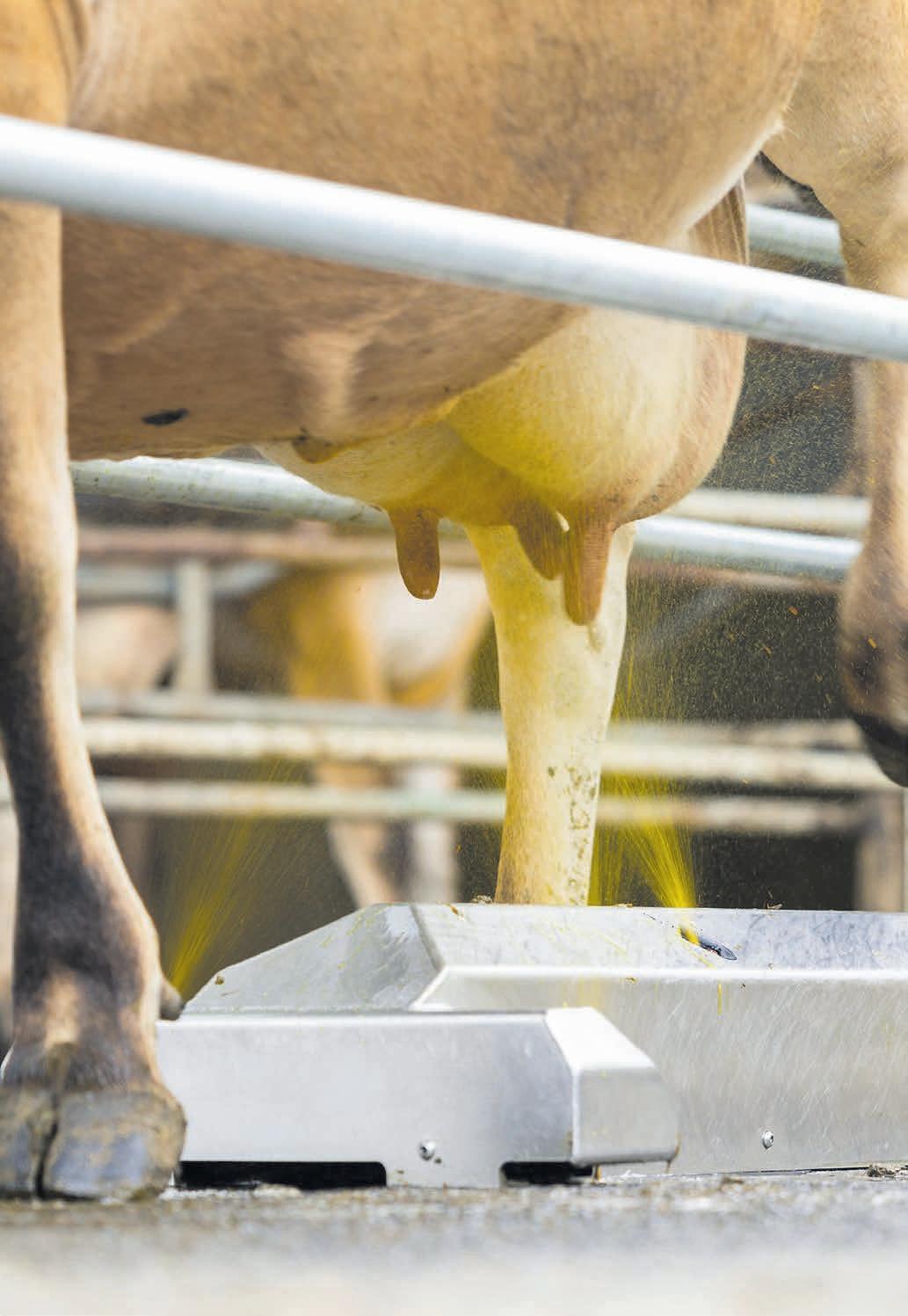
Upton throws shade on ETS forest rules

PARLIAMENTARY
Commissioner for the Environment Simon
Upton has slammed the government’s attempts to limit forestry planting for carbon as bureaucratic regulation that fails to address the real problems behind New Zealand’s Emissions Trading Scheme.
Submissions are being heard on the Climate Change Response (ETS-Forestry Conversions)
Amendment Bill, passing through Parliament now.
The Bill aims to limit the conversion of farmland to pine plantings used for ETS credits. It limits whole-farm conversions on Land Use Classification (LUC) 1-5 land and caps ETS plantings on LUC 6 land to 15,000 hectares a year.
It also allows for up to 25% of a farm anywhere to convert to forestry.
The commissioner has had a longstanding issue with the use of

carbon forestry offsets, pointing out NZ is the only country in the world to allow this.
In his submission, Upton maintains the Bill is dealing with symptoms, not the cause of ETS issues. These require much deeper reform than the Bill offers.
Upton’s office has forecast that falling emissions as technology advances is likely to see an oversupply of NZ ETS units as soon as the early 2030s. This will prompt a price fall and with it declining incentives to continue forestry after 2050. The forestry
Gold miner buys Central Otago station for $25m

Neal Wallace NEWS Land
LISTED gold miner Santana Minerals has paid $25 million for a Central Otago sheep station as it progresses a planned gold mine.
It has bought the 2880 hectare Ardgour Station near Tarras on which it plans to build the Bendigo-Ophir Gold Project (BOGP), which will use modern mining technology to work four historic deposits.
In a company statement, it said it will focus on the historic Rise and Shine (RAS) deposit, which it claims to be New Zealand’s most significant single gold discovery in the past 40 years.
The development will include an open pit 1km long, 850 metres wide and 200m deep, and an underground mine to access deeper extensions of the deposit.
Three smaller adjacent satellite pits are also planned, Come in Time, Srex, and Srex East.
The processing plant will be located in the lower Shepherds
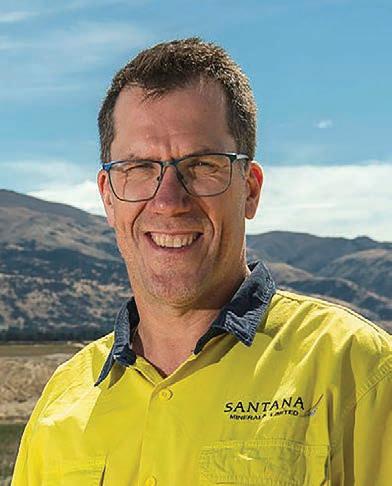
Valley and will use a process that includes an initial gravity circuit to recover gold followed by a carbonin-leach process that uses sodium cyanide to dissolve the remaining gold.
A cyanide destruction circuit
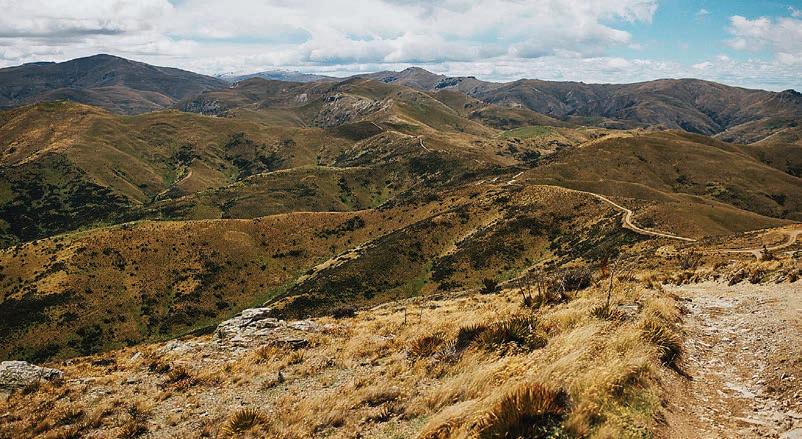
reliance will leave NZ struggling to maintain net zero after that date.
The commissioner maintains bureaucracy is likely to be the biggest winner with the Bill’s passing.
Landowners wanting to make use of the flexibility to afforest 25% of each farm’s LUC 1-6 land must provide detailed evidence about the property and its current land uses.
The requirements are even higher if a landowner wants to use one of the proposed exceptions.
He notes that the use of a random ballot for allocating the 15,000ha of LUC6 land means potential foresters must buy land before entering the ballot process, but are not guaranteed a “win” in the ballot.
“It will likely reduce the potential buyers for land, should the farmer want to sell. Other methods to allocate the quota could have provided greater certainty,” he notes.
He also states the Bill limits landowners’ freedom to deal with their properties as they choose, by limiting forest conversion to 25%
and making any area beyond this subject to ballot.
The Bill is also likely to create some unintended consequences, ironically including seeing more carbon forests planted, not less, on the steepest, roughest LUC 7 and 8 land.
“I have serious concerns about these forests. Once the income from carbon runs out, either because the carbon price falls or because the trees stop growing, there will be no income to look after these forests.
“There will be no way to ensure that the carbon within them remains locked up in the face of fire, disease and extreme weather events.”
As an alternative, the commissioner urges the government to consider using forestry as an offset for methane emissions, at a rate of about 0.6ha of trees per cow.
He says such an approach puts land use decisions linked to climate action into the hands of the sector itself, rather than setting agriculture and fossil fuel emitters up against the sector.
NZ-grown timber seeks its place in the sun
then reduces residual cyanide concentrations to below the level deemed safe for wildlife prior to discharge into the tailings storage facility.
“We are pleased to have completed a respectful and mutually beneficial transaction with the owners of the Ardgour Station,” said Santana chief executive Damian Spring.
“This secures our development rights for the majority of the Bendigo-Ophir Gold Project infrastructure and uncomplicates competing land uses when the project proceeds.”
Consent is being considered under the government’s fasttrack approval policy and gaining that approval is required for the transaction to be settled.
If approved, Santana said it expects to create 300 jobs, produce 120,000 ounces of gold and generate $6 billion in revenue over the life of the mine, paying more than $1 billion in taxes and royalties.
Ardgour Station is a traditional high country fine wool sheep and beef property that has been owned by the Jolly family since 1955.
Bruce Jolly says he will continue to farm the land until next autumn while he fulfils livestock and wool contract obligations.
It will be up to Santana what happens after that.
In 2020 Ardgour embarked on a partnership to develop a 38ha horticultural business, planting 15,200 cherry and 15,000 apricot trees, which will reach maturity next year.
Jolly said the orchards are on separate tiles and will not be impacted by the mining.

Richard Rennie MARKETS Timber
THE influence of raw logs on the forestry sector’s exports has surged in the past decade, with the commodity now accounting for over half the sector’s total export earnings.
Data from Figure.NZ shows export log income dependency has grown by a third since 2015, when logs made up only 42% of export income.
Last year they accounted for 56%, with forecasts estimating this proportion will level off in coming years.
Mark Ross, CEO of the Wood Processors and Manufacturers Association, said the “log effect” on the sector has been driven particularly strongly since 2019 by the removal of Chinese tariffs on all wood products under the terms of the New Zealand-China free trade agreement.
“For forest owners the best price for a commercial decision has been to export logs. We are, however, hoping this will start to turn in the coming years.”
He said with the sector’s longer term goal of doubling exports over 10 years there is no chance it could be achieved under existing forested areas through logs alone.
He said the sector wrestles with a perception in overseas markets that pinus radiata is not a quality timber product. There is a need for wider industry promotion of “NZ Inc” timber to grow awareness of its inherent quality.
“This is something we have done in the United States, and
it needs to be done in more markets.”
He said this could include a certified label, or simply having the industry work better together on promotional efforts.
“Unlike some sectors, take for example kiwifruit or dairy, we do not have people on the ground in markets to promote our timber. It’s something we have spoken about, particularly if we want to double our exports.”
Wood processors do not contribute to an industry levy fund, Ross said, and there has not been a lot of enthusiasm for this despite its potential value.
There are now few markets where tariffs themselves are insurmountable obstacles to building volumes, but there are ongoing challenges of non-tariff barriers like building regulations.
For example, Australian building regulations for timber “stiffness” limit the ability of NZ to supply the market.
Meantime Australian state and federal governments offer attractive grants to timber processors. This includes a AU$110 million federal grant funding option as part of a AU$300m industry support package.
Ross said it is welcome news to hear how much support NZ is getting from the building industry in the United States as its government considers new tariff levels. Even the US Chamber of Commerce is recommending that timber and timber products remain tariff free.
“And they are often on the right side of US trade decisions, so we stay hopeful.”
Richard Rennie NEWS Forestry
SLAMMED: Parliamentary Commissioner for the Environment Simon Upton believes plans around Emissions Trading Scheme forests will be bureaucratic, costly and ultimately ineffectual.
SITE: The Central Otago site where Santana Minerals plans to mine for gold.
OPEN PIT: Santana Minerals chief executive Damian Spring says the mine will include an open pit 1km long, 850 metres wide and 200m deep, and an underground mine to access deeper extensions of the deposit.
Looking beyond tourism and ag to balance economy

Richard Rennie NEWS Economy
ARMING at the foot of
FOtago’s Crown range and firmly in the heart of New Zealand’s tourist hub, Carlos Bagrie is better placed than most to challenge the dual importance of farming and tourism on his and New Zealand’s future.
Husband to food guru and entrepreneur Nadia Lim, Bagrie is very much at the sharp end of both sectors, as Queenstown’s tourism growth nudges the boundaries of the couple’s challenging 500 hectare Royalburn Station on Crown Range Road.
It is this duality of income and the limits they face that inspired Bagrie’s Nuffield scholarship study. That was to start a conversation about what the “third leg” of New Zealand’s economy could be, to exist alongside tourism and agriculture.
“I have tried not to deliver any one recommendation on what else NZ’s economy needs to do, but rather start a conversation on it. It’s not an easy one to have.
“Our growth in agriculture is pretty much looking to be more
linear than exponential heading into the future. It is not that there are not gains still to be made, it’s just those gains are more seconds than minutes in terms of performance lift.”
Meantime tourism cannot continue to rely on simply adding more jet landings and more campervans into its growth equation.
I have tried not to deliver any one recommendation on what else NZ’s economy needs to do, but rather start a conversation on it.
Carlos Bagrie Royalburn Station
Bagrie said the Nuffield work and travels were an opportunity to stand outside his business, and the country, to explore the implications of continuing to rely on two key planks in the economy.
He also sees two pathways unfolding in the world’s food production sector. On one level is the broadacre, expansionist approach of the likes of Brazil, capable of continuing to grow with
mind-bending scale.
“In contrast to that we have the likes of United Kingdom and Netherlands. Here production is becoming deliberately constrained.
“UK farmers [are] being paid not to farm and shift land to conservation, while Dutch farmers face high land values, and strict environmental regulations making traditional farming unviable as they pivot toward high value niches and supply chain control.”
As a result, UK food production has declined, with the country importing 40% of its food, double what it was 40 years ago.
The Netherlands in contrast has responded by becoming a plateto-shelf producer, distributor, marketer and logistics operator, now exporting more food than Brazil, despite being 0.5% of its size.
New Zealand’s distance to markets may prove an undeniable challenge to adopting a Dutch agri approach.
However, Bagrie said, there are some fundamental, robust foundations here, including NZ’s geopolitical stance, sound democratic system and low level of corruption, which make for good starting points for whatever third economic leg is chosen.
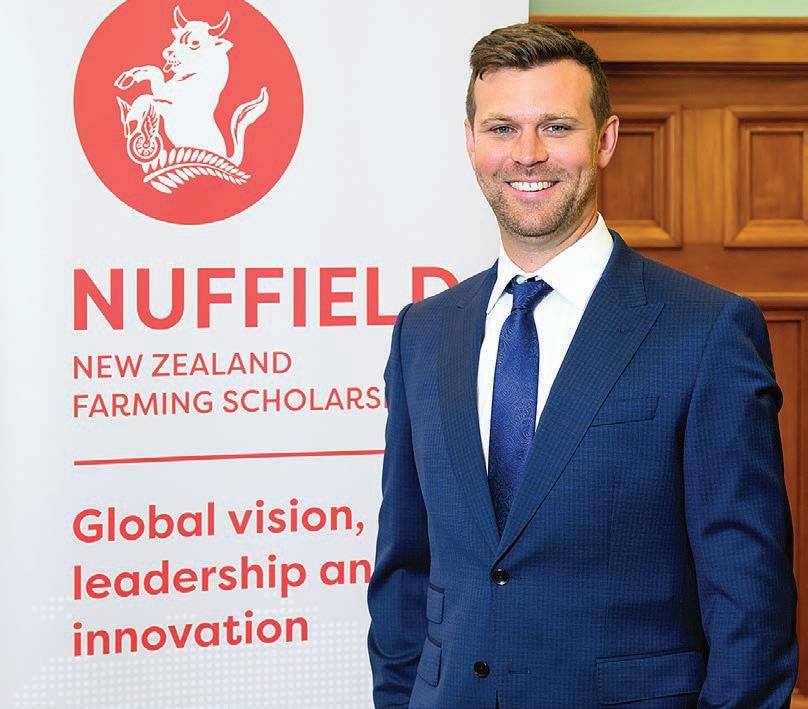
He offered up some examples alongside the Dutch model. They include Ireland’s pitch to attract high value industries like tech, or the opportunity to position ourselves as a leader in renewable energy or digital innovation.
“But you have to question something like claiming to build our [artificial intelligence] sector, when you are up against the likes of the Chinese and United States that have just such a big head start and resources already there.”
He agrees an option could be
to look at rocket technology, leveraging off Rocket Lab’s established success, and the suitability of sites like the Tāwhaki national aerospace centre in Canterbury.
“It would be a case of having bipartisan support, knowing that whatever we decide upon is not going to change in three years time with a change in government.
“But whatever we chose, it’s not to replace agriculture or tourism, it’s to grow the economy overall, and de-risk it along the way.”
Trusted by farmers for effective worm control with NIL MILK withholding periods and improved R.O.I
Studies in NZ dairy cows have shown the potent effects of EPRINEX® on parasites resulted in more daily milk, more milk protein and more milk solids.1,2

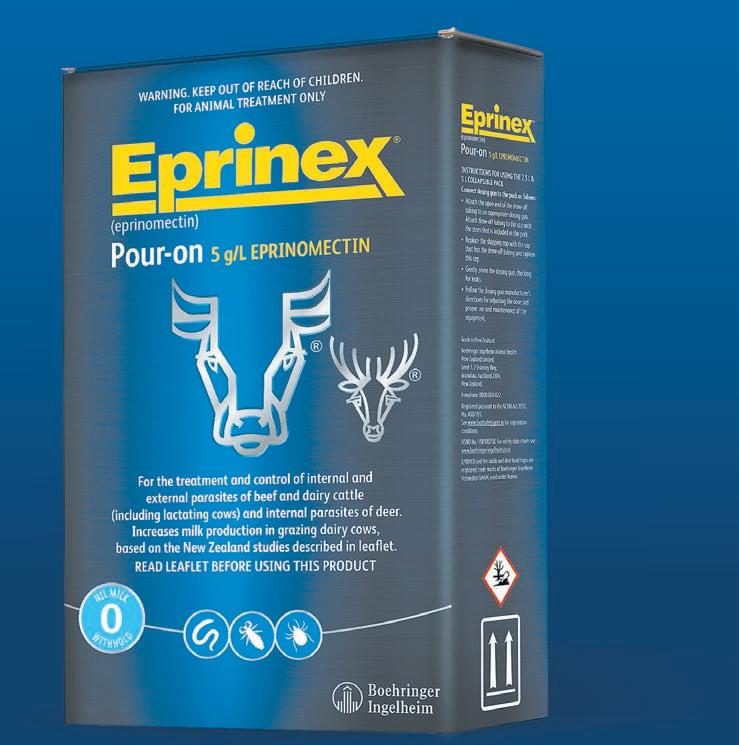

THIRD LEG: With gains in agricultural production slowing and tourism hitting limits on numbers, Nuffield scholar Carlos Bagrie is encouraging a national conversation on what other options NZ’s economy may have to enjoy stronger economic growth.
Eye on tax break to pull tractor sales free

Richard Rennie MARKETS Machinery
TRACTOR sales have slid to their lowest level in a farming generation, with tough farming years, bigger farms and more productive machines all pushing numbers down.
Infometrics CEO and economist Brad Olsen dug into New Zealand’s current and historic tractor sales going back 50 years to determine if there is a “tractor index” indicative of rural financial health.
“You often hear about what sales may be, particularly in the lead-up to Mystery Creek Fieldays.
“People talk about how tractor sales are seen as an index for economic health on farms. But our work showed they [tractors] may not be as much of an indicator as they once were.”
Olsen’s data shows year-to datetractor sales to this April totalled 1925 units, the lowest 12-month level they have been since year-todate August 2001.
The 12 months to April figure has been in a steady decline for the past three years, dropping by a third in that time.
Canty prof developing alternative to 1080

A NEW pest control compound being developed by a Canterbury University scientist sterilises pests by inducing the early onset of menopause.
Rudi Marquez-Mazlin, a professor at the School of Physical and Chemical Sciences, said the base compound in his product, dubbed Ratbegone, is delivered by bait and acts only on females, which become sterile.
The secret compound acts on specific traits in the gut of target species, with the initial focus on rats and possums.
The active ingredient in Ratbegone was originally discovered by chance when Marquez-Mazlin was involved in cancer research in Scotland.
He was giving it to rats that were being bred for the project, and found they were inadvertently becoming sterile.
Because it was irrelevant to his cancer research, the compound was set aside until Marquez-Mazlin moved to Christchurch.
“It was a case of unintended consequences, having a product from an earlier project that has turned out to be quite useful.”
Hunter friends told him about 1080, the biodegradable poison primarily used for controlling
However, sales volumes have hit lower troughs in the past.
NZ farmers peaked in their tractor purchasing at the start of Olsen’s data set, with 4544 machines sold in the year ended February 1974.
That preceded a definitive decline, bottoming out through the late 1980s to ’90s. Barely 700 machines were sold per annum as Rogernomics policies bit deep into farms’ survival.
I think we are quite likely to give those 2022 figures a good nudge in coming months.
Jaiden Drought TAMA
It took until 2001 to recover back to 1985 sales volumes, to peak at 3000 units in the year to August 2005.
“Some of the latest decline is due to farmers having been through some tough times recently. People would have been holding onto their tractors as long as possible, repairing rather than replacing,” Olsen said.
He anticipated the government’s 20% depreciation allowance on
new purchases in year one is still to feed through with a lift expected in September as postFieldays deals are settled and farm budgets firm up.
Tractor and Machinery Association (TAMA) president Jaiden Drought is optimistic there is a solid uptick in tractor sales still to come after two tough years.
“There has been a bit of a lull, but they don’t last forever, and you can’t hold onto your tractor forever.
“We have certainly reached peak tractor if you go back that far [50 years]. But I think we are quite likely to give those 2022 figures a good nudge in coming months.”
Sales year-to-date September 2022 hit almost 3000.
Drought said the government’s 20% depreciation allowance was generous and well received by farmers.
Farmers Weekly has calculated that on a $100,000 machine the extra allowance brings an additional $5000 tax benefit to the purchase.
Olsen maintained shifts in technology may be driving a slide in tractor sales, but Drought said he is not convinced.
“When it comes to things like drones, here in NZ they are
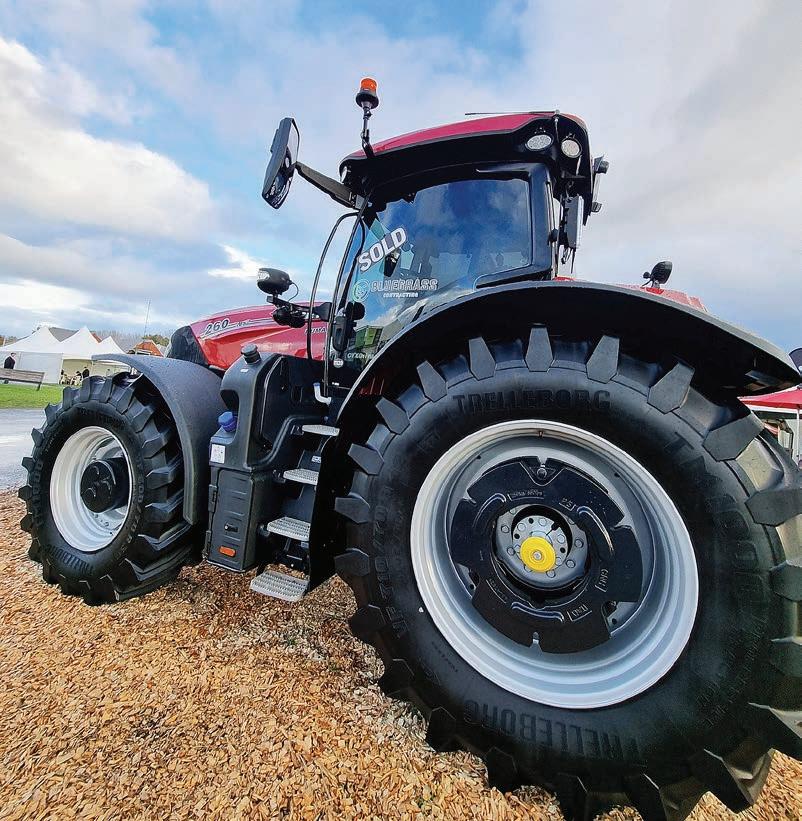
probably more likely to replace helicopters than tractors.”
He said the main cause for the historic slide is down to larger farms running bigger machines

introduced predators. While appreciating its role, he knew he potentially had a better, more humane solution.
Its development has reached a point where Marquez-Mazlin hopes to start field trials by Christmas.
“We’re really confident that it will help, that it will stop fertility and create sterilisation in possums and rats.”
Operating on the specific metabolisable gut environment of targeted species, it is innocuous to humans, ruminants, birds and fish, even if it is consumed.
Possums and rats find it appealing to eat.
It will be delivered via bait and Marquez-Mazlin said the uneaten compound quickly decomposes in the natural environment.
In trials, none of the rats treated with high doses of Ratbegone could become pregnant.
Some of those given lower doses had offspring, but all died within 12 hours.
Marquez-Mazlin attributed those deaths to developmental issues
during pregnancy caused by the compound.
Other than being unable to get pregnant, treated animals do not show any side effects and live out their lives as usual.
“They display normal behaviour. There are no changes in their demeanour.”
Disrupting fertility to control pest species has been explored previously but the approaches relied on what he called over-complicated delivery vectors and on toxic and nonsustainable biological or chemically active ingredients.
Marquez-Mazlin said next he will turn his attention to developing a compound for wild cats, stoats and ferrets.
Most domestic cats are sterilised by their owners so the impact will be minimal, but reducing the feral cat, ferret and stoat population will have a significant benefits for biodiversity.
The challenge with using wild animals in research is the lack of knowledge of their history or background and difficulty getting them to reproduce in captivity.
capable of doing more per hour. Meantime more farmers are employing contractors for seasonal jobs, and they too are capable of greater productivity per machine.
Leading fert firms hold line on prices

Gerald Piddock NEWS Fertiliser
RAVENSDOWN and Ballance Agri-Nutrients have kept urea prices unchanged, despite Rabobank’s Agribusiness Monthly July publication reporting a 9% month-on-month lift in global prices.
The lift was a result of an increase in tensions in the Middle East with the broader region, including Egypt, accounting for around 45% of global urea exports, Rabobank agricultural analyst Paul Joules said.
Iran – the world’s third largest fertiliser exporter – and Egypt, the fourth largest, have had production disrupted by the conflict.
“Iran’s output was halted due to damage to gas fields, while Egypt’s supply was affected by Israel cutting off gas exports. If peace holds, both nations are expected to resume production soon, which would help stabilise global supply,” Joules said.
“As far as New Zealand is concerned, the country is heavily reliant on urea imports, so any international supply shock directly translates into higher domestic prices.”
Ravensdown has urea priced at $953 a tonne direct while Ballance Agri-
Nutrients has Nrich urea for $933/t, excluding GST.
Ravensdown chief operating officer Mike Whitty confirmed that Middle East tensions did lead to a spike in urea commodity prices, but they have since returned closer to previous levels.
“Depending on world events and happenings, this sort of price volatility is not unusual (particularly for urea).
“However, in saying that prices are generally rising, supply is tight, and uncertainty in the short term has ramped up as a result of events in the Middle East.”
Ballance Agri-Nutrients customer general manager Jason Minkhorst said in a message to their customers in late June that while prices had not changed yet, the conflict along with a strengthening US dollar was putting upward pressure on these commodities.
The increased instability had also led to logistics and shipping delays, he said.
“While price movements are currently unpredictable, we will continue to keep you informed and do our best to maintain supply continuity at competitive pricing.
“At this stage, there is no clear indication of where firming prices will settle or how long the disruption will last,” he said.
SOLD: TAMA president Jaiden Drought predicts the full effect of the government’s 20% depreciation allowance is still to kick in to boost tractor sales this year.
Neal Wallace TECHNOLOGY Pests
PEST CONTROL: Rudi Marquez-Mazlin, a scientist at Canterbury University, has developed a compound that sterilises pests.
SUBSCRIBER
We support you and you support us…that’s how it works. You tell us you appreciate getting Farmers Weekly and want it to continue as a comprehensive weekly, and we want to keep delivering.
Most other news organisations do less, produce less, downsize, or have disappeared.
We’re determined to work with you to avoid all of those.
At $120 a year ($2.50/week, $10/month – fully tax deductible) Farmers Weekly might be your best value subscription.
We especially welcome the subscriptions of Federated Farmers members, and those who are going to join Feds now they see the benefit of their good work. The four Federated Farmers pages keep you up to date with their news every week.
We hope all farming families will join some, or all, of these valuable voluntary-membership groups, who represent your voice, your community and the next generation:
1. Federated Farmers.
2. Rural Women NZ.
3. Young Farmers.
4. Farmers Weekly.
They are powered by farmers, for farmers.
Today is a good day to lean in and share the load. It takes a team. Make a difference. Join the community.
Become a voluntary subscriber today and we’ll continue to share the good work of all.
Kind regards,

Dean Williamson – CEO and Publisher dean.williamson@agrihq.co.nz 027 323 9407
BECOME A VOLUNTARY SUBSCRIBER
Start your voluntary annual subscription today. $120 for 12 months. This is a voluntary subscription for you, a rural letterbox-holder already receiving Farmers Weekly every week, free, and for those who read us online.
Choose from the following three options:
Scan the QR code or go to www.farmersweekly.co.nz/donate
Email your name, postal address and phone number to: voluntarysub@farmersweekly.co.nz and we’ll send you an invoice Call us on 0800 85 25 80


Note: A GST receipt will be provided for all voluntary subscriptions.


From the Editor
Holding onto our talented young farmers

TNeal Wallace Senior reporter
HE recent FMG Young Farmer of the Year contest epitomised all that is great about our industry.
For 56 years it has been the sector’s premier public showpiece, portraying the enthusiasm, intellect, skill, commitment and passion of the next generation of farmers.
Waikato-Bay of Plenty’s Hugh Jackson deservedly won the title at his second attempt, seeing off six impressive finalists. Such are the skills and broad knowledge demanded of contestants that “FMG Young Farmer of the Year” is a title that is earned in the true meaning of the word.
Of particular interest to the next crop of farmers is a Rabobank white paper released at the Primary Industries NZ Summit that investigated the ever-present challenge of farm succession.
It found the largest ever intergenerational transfer of wealth will occur in the
LAST WEEK’S POLL RESULT
agricultural sector within the next decade, as more than half of all farmers and growers, about 17,320, reach the age of 65.
At current land values, the transition of those farming operations represents the transfer of an estimated $150 billion in farming assets.
It is a no-brainer that we need a succession of young farmers entering the industry, but that is financially becoming more challenging.
Successfully getting those young farmers and growers on the land requires structures and funding so the sector can use their enthusiasm, intellect, skill, commitment and passion.
Equally, it is a no-brainer that the success of the New Zealand primary sector has been built on the values and linkages to the land that come from family ownership, something we need to treasure and protect.
Concerningly, Rabobank found just one in three farmers has a formal succession plan in place.
A further 17% say they have discussed succession but have nothing documented, while the remaining 50% say they have neither discussed succession nor commenced a succession plan.
The study also revealed one-third of farmers intend passing their farm to their children but 39% report having no children seriously interested in farming.
Rabobank found financial obstacles to farm ownership are not getting any smaller, and have plateaued in recent years.
VOTERS were evenly split on whether meat companies are better off being farmer-owned. A tick over 50% thought it didn’t matter, with many pointing to the recent woes of Alliance and Silver Fern Farms.
“The current situation of Alliance and recent history of SFF would suggest they don’t work in today’s global red meat trade,” one said. “Co-ops are dinosaurs when it comes to change and sadly they have lost the ability to put their farmer shareholders’ first and foremost,” said another.
But of the 49.8% who believe farmer ownership is important, many thought the values that underpin the co-operative model still matter today.
“Our forefathers didn’t build Alliance so we could hand it over when times got tough. They built it so we – New Zealand farmers – would never be at the mercy of overseas giants. They gave us something rare: control, pride and a voice. We’re farmers. We know hardship, but we also know how to dig in. We don’t walk away. We stand up. Shoulder to shoulder. If ever there was a time to fight for our co-op its now.”
Traditionally, succession has referred to the transfer of farm ownership from one family generation to the next, but the report found there are alternative ownership structures and land-use opportunities.
Succession can also mean transitioning into a different state of ownership and/or operation.
Rabobank found financial obstacles to farm ownership are not getting any smaller.
These options could become increasingly relevant as sons and daughters opt for careers other than farming.
It could also avoid the expectation or obligation that sons or daughters feel that they have to take over the family farm.
Rabobank says succession is a process, not a moment in time. It takes time, is intensely personal and specific to each business and there is no off-the-shelf solution.
The earlier succession planning starts, the better.
Succession looms as a significant challenge for the sector. The future of our industry and the economic viability of the country depend on finding affordable and viable ways to get the likes of Hugh Jackson and his impressive cohorts onto the land.
As Rabobank found, the evidence is that may not be in the form we have come to expect.
Last week’s question: Is it still relevant for a meat company to operate as a 100% farmer owned co-operative?
Letters of the week
The last generation
Patricia Hosking Rotorua
JASON Barrier, in “Climate change: the real question” (Letters, June 23), right after claiming he’s not a climate denier, proves he is when he argues that climate change is not an existential threat to our children, that we need to stop telling our kids that it is, and that the real issue is “How do we adapt to climate change while preserving the integrity and profitability of our farming industries?”
Respectfully, Jason, climate scientists have repeatedly sounded the alarm over decades, which you not only choose to ignore, you choose to make your kids’ lives a living nightmare.
Since your letter was published, Marlborough has had two 1-in-100-year floods. The year-long drought in South Australia has forced farmers to sell off all their stock. The recent flood in Texas, which saw water rise 8m in one hour, has killed [more than 100 people].
These events are predicted to occur with increasing severity and frequency. You cannot adapt to fortnightly 1-in-100-year floods, 8m floods or year-long droughts. I’m doing something about it and hope you and everyone else does the same because we can beat climate change if we choose to. I’ve stopped taking overseas holidays, have put solar panels on the roof, I bought an EV, planted thousands of trees and recently a planted a native forest. I also regularly host overseas kids and they all know climate change is destroying their futures. They say they will not have children, which I think is a reasonable informed choice given the world we are leaving them. They call themselves the last generation.
We’re so over Horizons
Ron Frew Ohakune
RECENT speculation around the future of regional councils following reforms to the Resource Management Act will have raised the hopes of both urban and rural ratepayers in the Horizons region.
We have watched helplessly as successive boards have allowed an expansion of activity into areas far removed from the catchment management for which they were originally set up.
The consequent explosion in highly paid employment numbers at Horizons has seen rate increases consistently exceed the rate of inflation.
Together with ever increasing charges for consents, this has placed an excessive cost burden on farmers and businesses. Clearly New Zealand cannot afford three layers of government bureaucracy – and regional councils should be the layer that goes.
This week’s poll question (see page 4):
Do you think all food products should state on the label whether they have been genetically modified?
Cut through cultural clutter with a coach
Eating the elephant
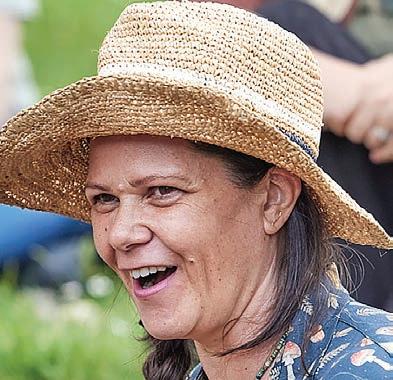
Nicole Masters Masters runs Integrity Soils, an agroecological coaching business working across 30 million acres of farmland globally.
This week the elephant eaters hand over to a guest columnist.
IWAS once told by a university lecturer in New Zealand to take emotions out when working with farmers.
But as an international coach and educator with two decades of experience working alongside farmers in New Zealand, the United States and elsewhere, I can tell you that farmers make decisions from the heart and stomach, as much as the head and balance sheet.
The decisions farmers make –to plant or not plant those trees, buy equipment, experiment with stock rotations or breeds – are all
underpinned by far more than data and information. Research shows that 90% of these decisions come down to intuition and gut feel.
I’ve seen it again and again. When farmers are supported to drive their own innovation in their own way, everyone benefits –from ecosystems to communities to balance sheets. Big, lasting on-farm changes like these start inside the farmer – not in the Beehive, boardroom or laboratory.
Since the 1980s, the loss of government-funded advisory services has left a gap filled largely by fertiliser reps, banks and university-linked extension programs. While some advice has been useful, much of it is now out of step with the demands of a changing world and dynamic farming landscape. Critically, traditional advisory services treat intuition and feelings as a liability – when they are central to resilience, innovation and change on farm.
New Zealand’s farmers face growing challenges, from stricter environmental regulations to extreme weather events. To keep up, we need to augment traditional consultancy with a new type of support service. It’s time to shift from experts to coaches.
From top-down consultancy to farmer-led innovation, from static advice to dynamic coaching – this is a different way to empower farmers to make big decisions. So what do farmer coaches do differently? They draw on systems
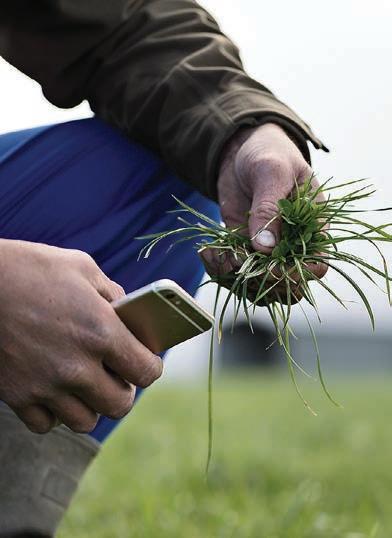
DECISIONS: The decisions farmers make – to plant or not plant trees, buy equipment, experiment with stock rotations or breeds – are all underpinned by far more than data and information, says Nicole Masters.
thinking, agroecology, agronomy, observation, and people skills to meet each farmer where they are –understanding that no two farming systems are alike.
Rather than prescribing solutions or stock standard recipes, holistic coaches help farmers develop the confidence and tools they need to craft their own strategies, understand their own systems and analyse their whole operation.
This shift builds critical thinking confidence and self-reliance –enabling farmers to innovate and adapt by themselves.
Agroecological coaches are trained in active listening, conflict resolution and emotional intelligence. Skills that are often undervalued, yet central to the change process.
Like Henry Ford said, “If you think you can, or think you can’t, you’re right!” Having a sounding board to bounce ideas off, confront assumptions and shine a light on our own blind spots is by far the most valuable tool we have in farming to change our own performance.
To those who would brush off this call for agroecological coaching as “woo-woo” or “soft”, I say look at Montana.
This US state is deeply conservative and polarised, and has some of the lowest levels of agricultural regulation in the US – but is witnessing one of the highest concentrations of regenerative land management in North America.
A quiet revolution is underway here, as ranchers shift toward biodiversity, soil health and improved grazing systems. In some areas we are seeing over 40% of land area shift towards agroecological management.
This transformation in the land and ranchers of Montana shows how coaching supports landowners to cut through cultural, personal and political barriers to change.
These farmers and ranchers are understanding what really matters to them and their land, and just getting on with the
hard work of landscape change.
The Ecdysis Project, which assessed 1284 farms across the US, shows how a soils-first approach, combined with committed communities and farmers, can deliver ecological and financial returns. Proof that we can have our cake and eat it too.
Right now, NZ Ag faces a serious shortage of trained coaches. While there are many passionate consultants and facilitators, few have formal training in the agroecology, systems thinking, navigating divisive issues and other communication skills needed to support complex change on farm.
It’s time to evolve and adapt. To prioritise relationships over recipes, confidence over compliance and long-term thinking over short-term fixes.
As the global shift toward regenerative land management and Scope 3 emissions reductions accelerates, New Zealand’s agricultural sector must respond. We need to reach across the fence to find solutions that benefit all. This future won’t be shaped just by more tech, new practices and new rules. It will need deeper conversations, better questions, more capable farmers and courageous thinking – all empowered by a new generation of coaches.
SOPI paints a highly optimistic picture
Meaty matters
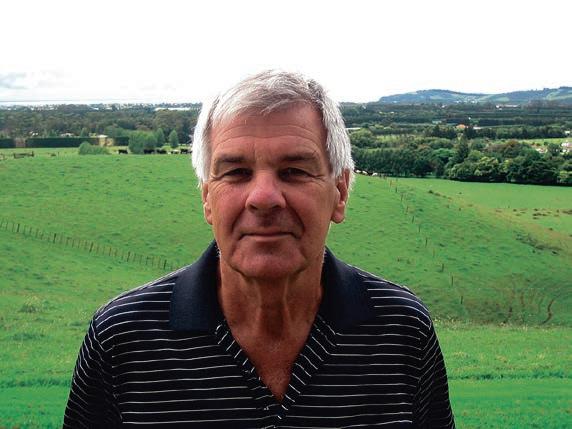
Allan Barber
Meat industry commentator: allan@barberstrategic.co.nz, http:// allanbarber.wordpress.com
THE Ministry for Primary Industries’ latest Situation and Outlook for Primary Industries report may be justified in its prediction of total primary sector exports of $59.9 billion for the year ended June 30, rising to $61.4bn for the next 12 months.
The main reason for the projected increase is firm prices underpinned by tight global supply for most commodities. Threats are attributed to geopolitical tensions and tariffs.
The report assumes the steady increase in primary sector exports, predicted to reach $65.9bn by 2029, will continue uninterrupted without any recognition of other
possible factors that might prevent it being achieved.
Any number of unforeseen events could prevent this figure being achieved, among the possibilities being outright war disrupting world trade; the collapse of the tariff-based global trade system, already severely weakened by United States President Donald Trump’s unilateral declaration of tariffs on US imports; climate disasters affecting New Zealand production; or the disruption caused by another pandemic.
This list of adverse events does not include sector-specific risks associated with government policies, like climate change commitments, the Emissions Trading Scheme and pastoral land allowed to be sold for forestry conversion, particularly affecting numbers of sheep and prime beef. After all, the productivity gains that have compensated for fewer sheep for many years now can only go so far, unless the decline in sheep numbers stabilises. While the present government is more aware of the need to avoid policies that unduly penalise agricultural production, its focus on freeing up land for housing development poses a threat to productive land on the outskirts of large population bases.
The prospect of a change of government with a return to the
less agriculture-tolerant policies of Labour and the Greens is also a concern.
The Situation and Outlook for Primary Industries (SOPI) report highlights the critical importance of agriculture to the New Zealand economy: the food and fibre sector represents 51% of our total exports, 10% of gross domestic product and 12.4% of employment. In year to June 2025, dairy made up 45.7% of the sector’s total, meat and wool 20.5%, horticulture including wine 14.2%, and forestry 10.5%.
At some point supply and demand will inevitably come back into balance.
Feedback from some meat exporters indicates real concern about the trends evident as this season progresses. Prime beef supply is down 12% year on year, the bull kill is down more than 5%, while lamb numbers are down nearly 10%, whereas the ewe kill is 250,000 higher year to date.
The reduced level of supply is clearly reinforcing the firm price trend that sees farmers being paid in excess of $8 per kg for prime and up to $9.80 for lamb. These livestock costs are causing most processors to blink, but without a combination of greater supply and less processing capacity,
the pressure is likely to persist. For now the market price remains at historic highs, but at some point the market will refuse to pay these prices and the industry will have to react. Although farmers no doubt will be hoping for the golden weather to continue, at some point supply and demand will inevitably come back into balance and push market prices down. Either way slaughter capacity will come under threat.
While dairy is less vulnerable than sheep and beef to land use change, it is also bolstered by high prices. However, the latest DairyNZ forecast break-even cost has risen 27 cents to $8.68 per kg of milk solids, while next season’s opening payout is $10. It would not take much of a hit to global dairy prices, for any of the reasons listed earlier, for the profit margin to become uncomfortably slim, particularly when debt repayment is factored in.
Much is made of the fact we tend to rely too much on a limited number of markets, but this is dictated by the need to maximise the price. It doesn’t make economic sense to sell at a lower price to an alternative market or customer, unless there is a strategic reason to do so.
Meat and wool exports are reasonably well spread, with the US and China buying 28% and 24% respectively by value,
followed by the European Union (14%) and several markets – the United Kingdom, Canada, Japan and Australia – taking 4-5%.
Smaller but still significant buyers, including South Korea, Taiwan and Indonesia, round out the top 10. Dairy, in contrast, is less balanced, with exports to China making up 35% of the total and half a dozen others taking between 4% and 5%.
Horticulture has the best spread of export markets with 10 countries contributing 88% of the total, with China the largest at 18%, followed by EU (16%), US (14%), Australia (10%), Japan (10%), UK (6%) and Taiwan (5%).
New Zealand’s dependence on China is graphically illustrated by the fact meat and wool is the only agricultural sector for which it is not the biggest customer, last year at least. Overall China buys 29.9% of sector exports, followed by the US, which takes 11.5%.
As a small country, totally reliant on our ability to trade with the world, it is naive to think we can afford to choose one or other of our biggest trading partners. As Vangelis Vitalis reminded the Primary Industry Summit, we must built resilience through strategic trade depth.

MORE:
Masters is hosting a three-day Soil Health Masterclass in Waikato on August 19–21.
Sector Focus
YouTube clicks, pet hotels sustain UK farm

Annette Scott NEWS Agriculture
DIVERSIFICATION has become a necessity to survive financially, United Kingdom arable farmer and entrepreneur
Olly “Blogs” Harrison told the Foundation for Arable Research’s 2025 conference at Lincoln University.
Presenting via video link, Harrison said initially diversifying was about expanding his business, but he quickly found it was more a necessity to pay the bills.
Harrison left school at age16 having struggled with dyslexia. His farm has grown from 70 hectares to 600ha. His farming business has 14 different income streams, including dog-walking fields, chipping wood for biomass, sunflower mazes and office and holiday rentals.
Harrison said that while turnover is split 50-50 between on- and offfarm activities, 100% of the profit comes from diversification.
“UK agriculture is in a difficult space, particularly the cereal sector.
“With the cost of land, fertiliser and chemicals, the economics of cereals don’t add up. So we’ve got to sell it better or do something else.”
Harrison farms a mix of wheat, barley, spring beans, oilseed rape and grass.
It was like, wow, free money, as I was making the videos anyway.
Olly Harrison Cereal farmer
His biggest crop is grown for bird food, for which the government pays £642 a hectare, under its Sustainable Farm Initiative (SFI).
“This is propping up the farm for three years.
“Some farmers have stopped growing commercial crops. They are using contractors and just relying on the SFI for income. They have basically retired.”
He said the government and the wider population need to be more aware of the importance of being self-sufficient in food production.
“Growing flowers and planting trees isn’t going to feed the nation.”
Farming on the outskirts of Liverpool, Harrison has taken advantage of being on the urban fringe, turning farm buildings into office space and holiday rentals and charging £10 an hour for people to walk their dogs in a field.
The farm is self-sufficient in solar power, with some electricity being sold back to the grid. Tree waste provided by arborists and gardeners is used in a bio-mass boiler for drying grain.
A small animal hotel is in a cheap conversion of an existing farm building.
“While there are a lot of accommodation facilities for cats and dogs, no one was specialising in small animals like rabbits, hamsters and guinea pigs.
“One person paid £2000 for their
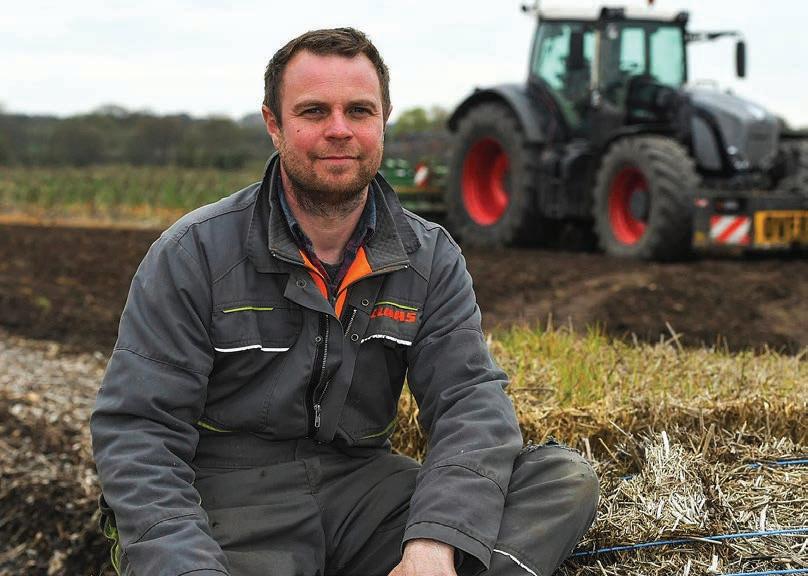
pigeon to be housed while they travelled for six months.”
Filming farming videos for YouTube started off as a bit of fun and a way to communicate with a wider audience during the covid lockdown, but has now become a useful revenue stream.
After several months growing an audience, Harrison set up a monetised channel. The first morning he woke up to find he had earned £1.52 in advertising revenue, and this continued to increase each day.
“It was like, wow, free money,
PGW Seeds sets new strategy and purpose
Staff reporter NEWS
CONNECTING more closely with seed growers, retailers and farmers is a key business priority for the newly appointed chief executive officer at PGG Wrightson Seeds Oceania, Hugh McDonald.
He was appointed to the role in early June after 12 years with the company, including the past two years as its general manager for supply chain and the previous decade as national sales and marketing manager.
PGG Wrightson Seeds is a fully owned subsidiary of global seed powerhouse DLF, which McDonald said provides huge opportunities to tap into its massive research and development capacity as well as operational and logistical expertise.
Earlier this month, DLF launched a new corporate purpose and group strategy for its global business.
The new DLF purpose is “We enrich land, life and people through seeds and science”, which McDonald said captures the intention to create more value for its customers and farmers, and society more broadly.
He said the strategic plan, Connecting to Grow, is about joining forces, both internally and externally, to make the company stronger as a global seed business. Seed growers, retailers and their farmer customers will not see immediate changes in the
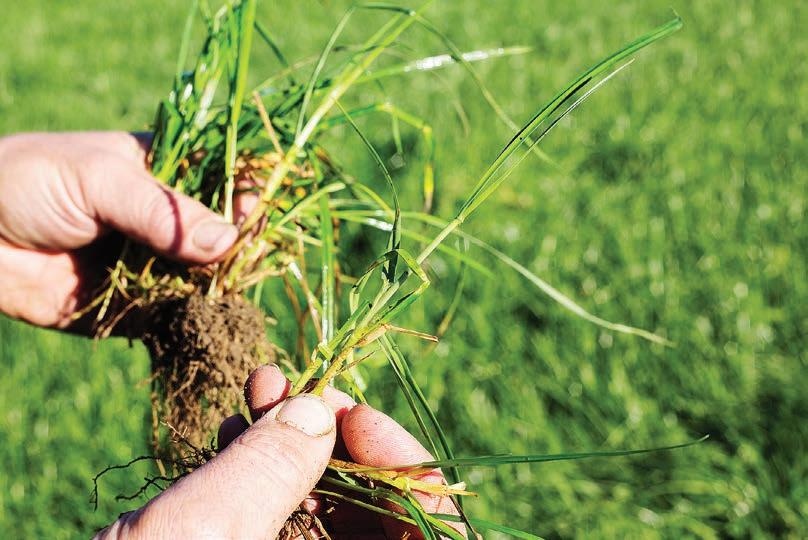
way the company interacts with them. McDonald said it will be a more subtle and steady shift in the way the company operates in the future.
“It is business as usual to a degree. The new purpose and strategy are exciting initiatives for DLF and mark an important step in its development as a global seed company,” he said.
The new global strategy is built on three pillars: people and culture as a driving force; strengthened market leadership; and the development of more scalable, standardised structures or systems that operate globally across all DLF companies.
“It starts with linking more closely with people at each step so we get the right information
about what’s required, so our plant breeding teams can deliver the right products back to seed retailers and on to their farmer clients.”
McDonald said PGG Wrightson Seeds will remain a seed wholesaler, selling to retailers who on-sell to their farmer customers.
“But connecting more closely with growers and others in the value chain will help bridge that gap in information flow. We might not deal directly with farmers, but we want people that buy through our retailers to know they get good value from our products and we leave value on farm for them too.
“Above all, our ultimate goal is to be the easiest seed company to deal with. When our retailers and farmers see the value that we’re
Above all, our ultimate goal is to be the easiest seed company to deal with.
Hugh McDonald PGG Wrightson Seeds
adding to their businesses and we have an optimised supply chain, I think we’ll be close to achieving that goal.”
The area of farmland being regrassed has declined, mostly as a result of reduced farm profitability over the previous two years, but he is hopeful the recovery in farmgate prices for milk, red meat and wool will see a speedy increase in the area of “grass to grass” pasture renewal.
Dry matter yield will remain a priority for the company’s team of plant breeders, but McDonald said seasonal production and other traits like disease or pest resistance, persistence and new endophytes are becoming more important.
“This is where our connection to DLF’s global R&D programmes is going to help deliver solutions for our end-users [farmers] in the future.
“We still want to ensure local value is added, even though we’re owned by DLF.
“One way for us to do that and gain a competitive advantage is by employing the right people, and using our feedback loops back to retailers, consultants, industry groups and farmers,” he said.
as I was making the videos anyway.”
His online presence now helps to fund his agricultural machinery obsession with the money going to the monthly hire purchase payments on a self-propelled sprayer.
Having an online presence has also helped to gather support for farming issues.
“YouTube has allowed me to expand my farm and to have a bigger voice when it comes to getting people together and lobbying the government.”
Plant breeders dig deep into gene Bill

Annette Scott NEWS Horticulture
PLANT breeders will gather next month for a forum focused on the future of gene technology in plant breeding. New Zealand Plant Breeders Research Association (NZPBRA) president John Carradus said the forum follows the successful inaugural sector event held last year.
This year the focus will be on the likely impact of the new gene technology Bill with risks, challenges and opportunities being addressed through the day-long gathering.
Keynote speakers will include Farmers Weekly senior reporter Richard Rennie from Laurich Communications with an overview of the Australian Regulatory System; David Hudson from SGA Solutions on GM and non-GM coexistence of crops in Australia; and Professor Emily Parker, science adviser to the Ministry for Business, Innovation and Employment addressing New Zealand gene technology regulations.
DIVERSIFICATION: United Kingdom arable farmer and entrepreneur Olly ‘Blogs’ Harrison says UK agriculture is in a difficult space with farm diversification now making up 100% of his business profit.
DECLINE: Hugh McDonald says the area of farmland being re-grassed has declined, mostly as a result of reduced farm profitability over the previous two years.
FEDERATED FARMERS
Vol 3 No 27, July 14, 2025

Flood-hit farmers need our help
Federated Farmers is calling on Kiwis to get in behind floodaffected farming families at the top of the South Island, as recovery efforts ramp up and the scale of the damage becomes clearer.
President Wayne Langford visited the area on Monday July 7 and says the destruction in parts of Nelson and Tasman is extensive, with some farms totally unrecognisable.
“I drove back up through the Motueka River and you can just see where it’s come through and swallowed everything in its path. It’s total devastation,” he says.
“One farm I visited had about 50 hectares taken out. The river changed course and just chewed right through it. Orchards nearby got absolutely smoked as well.”
Langford says it’s clear some properties have been hit far worse than others – and that those farmers urgently need our support.
“The damage can really vary. Some places have just lost boundary fences, but others have lost entire blocks. I met a guy who has lost a quarter of his farm.
“It’s heartbreaking to see, and the real kicker is that the worst of the damage is to farms right by the river – which are also some of our most productive.”
He says it’s now time for the rest of the farming community to do what we do best in times of adversity –to get in behind these families and show them some support.
“We know what to do in these situations. The Rural Support Trust is
doing good work on the ground, and local volunteers are already rolling up their sleeves.
“For people who really want to help, the best thing they can do is donate to the Farmers Adverse Events Trust. That’s the best way to get the support to where it’s needed most.”
The trust is designed to get funding directly to farmers who have suffered extraordinary loss – not just business-as-usual setbacks, Langford says.
“This isn’t about helping people who’ve had a fence or two knocked down. It’s for when something big has happened that puts a farmer’s viability at risk. That’s when we step in.
“We really want to give these farmers a hand. Not just a few rolls of wire and fence posts, but maybe also a post driver or a bit of digger work to help them get back on their feet.
“That’s the level of support that’s needed, so that’s what we’re aiming for – but it takes real money to do it.”
Langford says the first round of support payments from the trust will go out on Monday July 14, but the scale and speed of the response depends entirely on donations.
“In the past, we’ve raised millions, like after Cyclone Gabrielle. But this time around, we need people to dig deep again. Whether it’s $20 or $20,000, it all helps.
“The sooner we can raise the money, the sooner we can get support on the ground and the help these people need.”
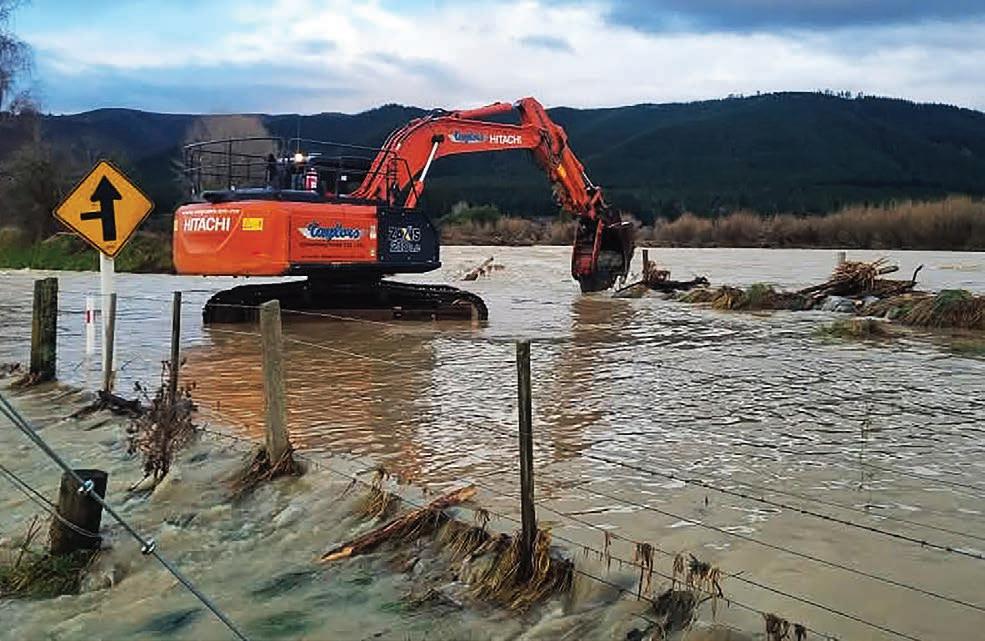
By a country mile, it’s the worst flooding event I’ve experienced.
Kerry Irvine Nelson Federated Farmers president
Kerry Irvine, Nelson Federated Farmers president, says the damage in the Motueka Catchment is the worst he’s ever seen.
“By a country mile, it’s the worst flooding event I’ve experienced.
“Some farms are just a mess.
One guy’s river-edge block has completely gone. Another farm had stock relocated because they’ve only got two standing fences left.”
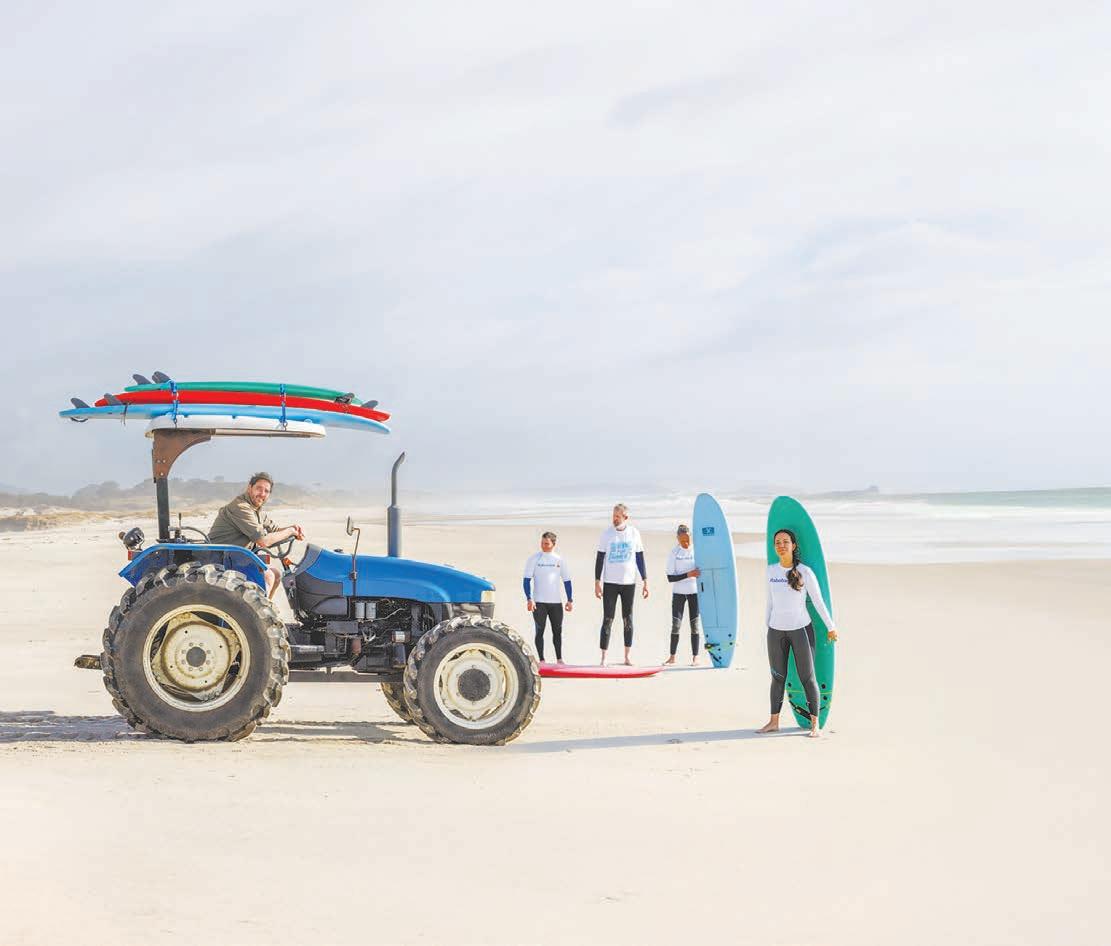
Paddocks as far as 800 metres from the river have been swamped, roads are still under water, culverts have been washed out, and in some cases, access tracks need to be rebuilt entirely.
And while feed levels are good, it’s infrastructure that farmers desperately need.
“The feedback I’m getting is clear: fencing gear, gates, culverts, posts, netting, and machinery like diggers to clear gravel off paddocks,” Irvine says.
“That’s the stuff that’s going to make the difference right now.”
Irvine says the mental load of the disaster is heavy.
“Some farmers are still in shock, while others are powering into repair mode.
says it’s clear some properties have been hit far worse than others – and those farmers urgently need support.
“Everyone’s got a story and while some are worse off than others, there’s hardly a farm in the region that hasn’t copped some kind of damage.”
How you can help
Federated Farmers is urging people to donate to the Farmers Adverse Events Trust to support flood-hit farmers in the NelsonTasman region. To donate, visit farmersadverseevents.co.nz/ donate
The Trust is a registered charity, so to ensure your donation is tax-deductible, email pforrest@ fedfarm.org.nz to request your receipt.
The Rabo Communit y Fund. Helping farmers catch a break .
By suppor ting dozens of rural initiatives we’re helping to grow vibrant rural communities
New Zealand’s only specialist food and agri bank , we understand the impor tance of strong rural communities hat ’s why we set up the R abo Community Fund to suppor t ommunity-led initiatives like Sur fing for Farmers, Meet he Need, Growing Future Farmers, and Garden to Table nitiatives that help our rural communities to grow and thrive find out more, go to rabobank.co.nz/community
PITCH IN: Federated Farmers president Wayne Langford
Photo: Tasman District Council
Dawkins wants pests and weeds knocked down for the count
Boxing taught Richard Dawkins the value of perseverance and determination – lessons he’ll harness as he steps up to fight the farmers’ corner.
The newly elected Federated Farmers meat and wool chair has around 20 amateur bouts under his belt, including a fight for the welterweight title at the 2018 national championships – one he lost on points.
“Boxing gave me a good foundation,” he says. “It’s lonely in the ring; no-one’s coming to help you. You get a result on your own merits and hard work. I think there was a good life lesson in that.”
Fortunately, Federated Farmers has a whole team working hard to knock over misguided regulations and unnecessary costs that hinder food and fibre production – the backbone of both farming families and the national economy.
That’s a factor Dawkins wants to highlight.
“I’m the chair, but it’s more than me,” he says.
“The support I’m getting from the seven Feds meat and wool executive members can’t be overstated.”
Backing the executive is the Meat and Wool Council – “the engine room” as Dawkins calls it – with representatives of all 24 Feds provinces.
“It’s hugely important that Feds gives all those representatives exposure and personal development.
“We are a grassroots organisation and we must understand local issues and provide practical solutions.
“We must also power up that leadership potential – not just for farming but for all the other things they’re involved with in their communities.”
Central to the council’s strategy is the Save our Sheep campaign.
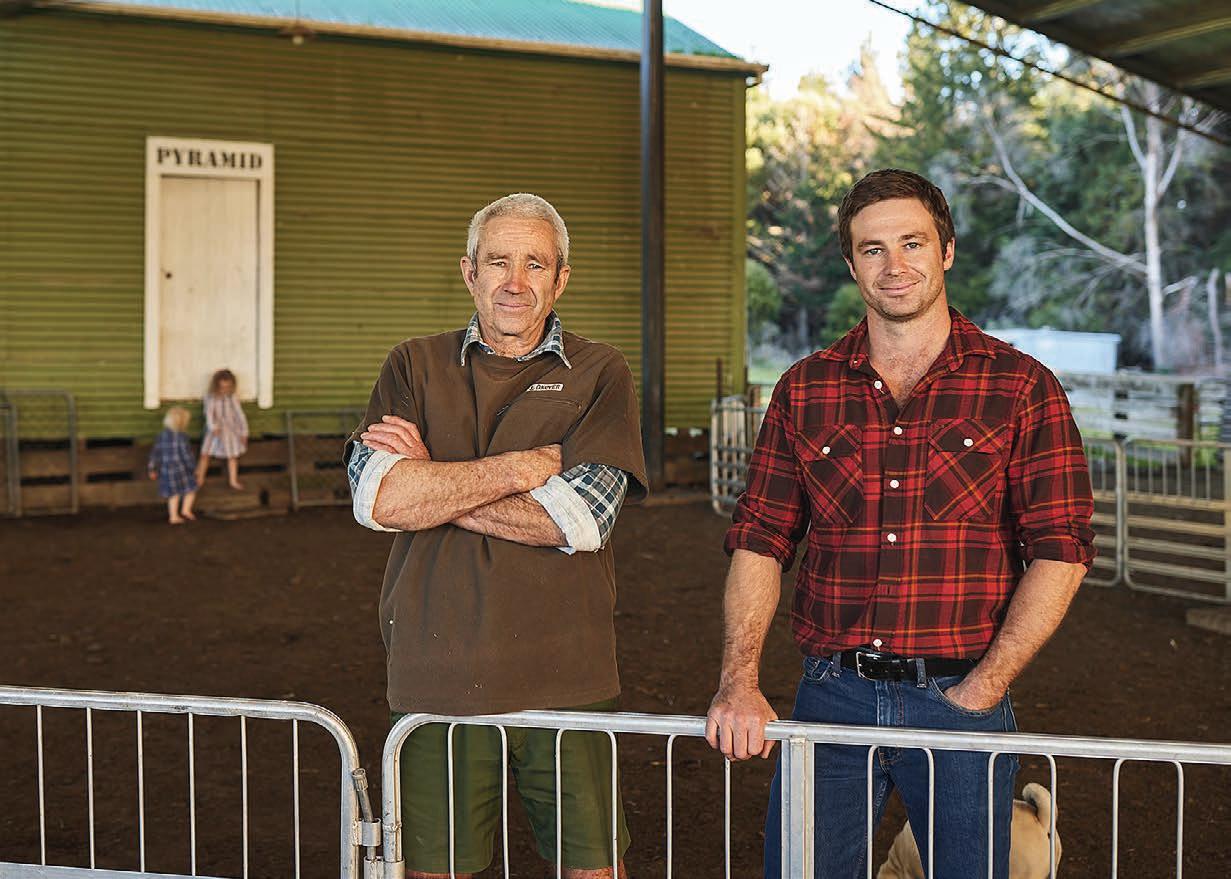
crown pastoral leases and grazing rights in the DOC Estate.
wallabies spreading, it’s past time for concerted action.
Dawkins, 35, and wife Jess farm at The Pyramid in the Waihopai Valley, 30km southwest of Blenheim. Dawkins’ grandfather moved to the property from Port Gore in the Marlborough Sounds in 1954, and Richard and Jess’ three young children are the farming family’s sixth generation.
The now 602ha farm, 19% of it in production timber and native restorations, has bees and a vineyard under Dawkins’ brothers.
Richard’s father Chris works with Richard to run a composite ewe flock primarily focused on meat production, Friesian bulls sold at two years to the works, and Jerseys leased to dairy farmers for mating. Dawkins, who completed a Kellogg Scholarship on lamb mortality, has for the last eight years lambed indoors.
Unlike most Kiwi sheep farmers running extensive systems on lowinput genetics, his composite ewe flock is highly fecund, and lambs need a management plan to cope.
“I call it a hybrid system. They’re not inside for long and it is very targeted toward highest risk animals.”
There’ll be no shortage of effort going into my new role and I’m looking forward to the sector reaping the rewards.
Richard Dawkins Federated Farmers meat and wool chair
Intended outcomes are a commitment from the government to tighten carbon credit restrictions to 25% of plantings on all Land Use Classes, for no agricultural emissions pricing or the development of a pricing framework and expanded
“Top of the list is improved weed and pest control, which is directly related to these other objectives,” Dawkins says.
“Our 2024 survey showed animal pests alone were costing NZ farmers at least $213 million a year.
“We welcome a collaborative approach with foresters and the Department of Conservation to address these issues.
“There’s frustration about deer and pigs coming out of forestry blocks but there’s eight million hectares of DOC estate too.”
“When you see evidence of newborn lambs being killed by wild pigs, large herds of deer and
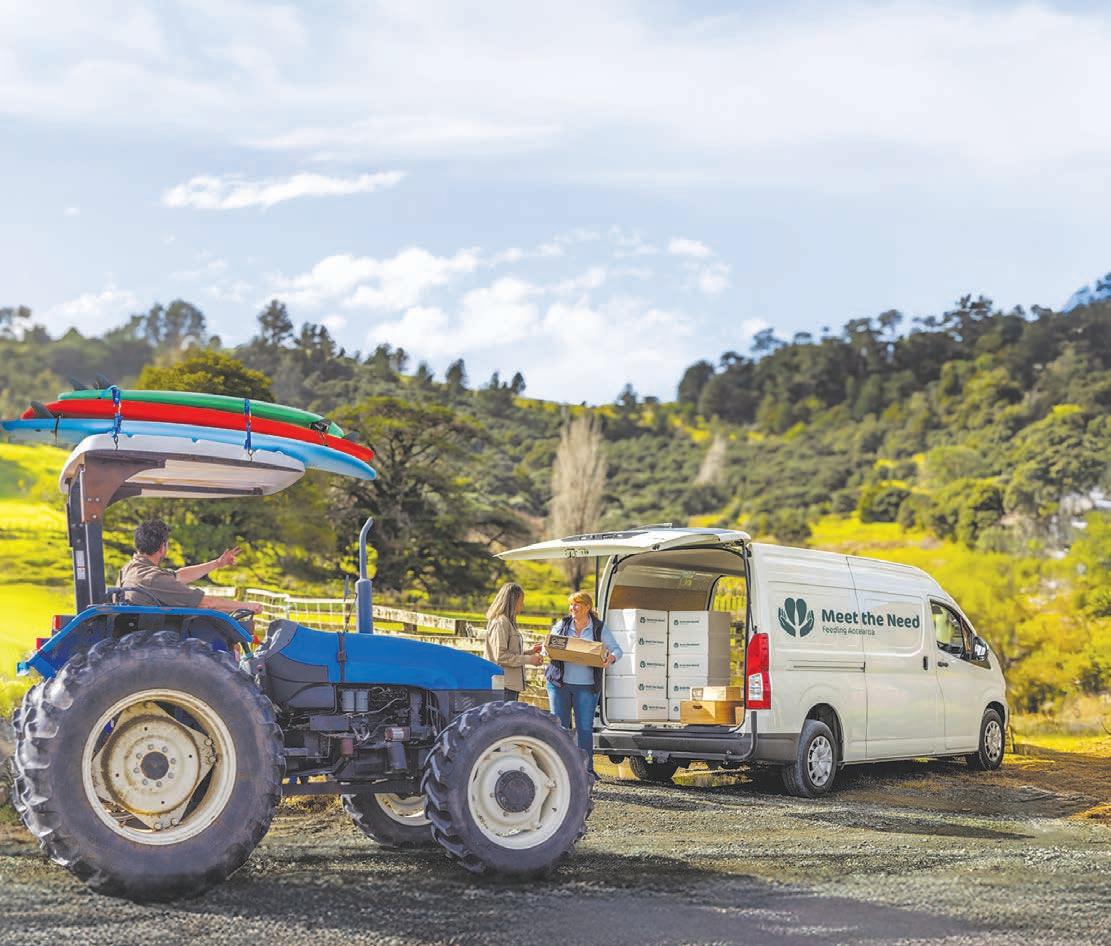
“Solutions are more in-depth than simply asking for more money.
The Government has made it clear budgets are tight.
“We need to be more strategic, to use technology and local knowledge – but also common sense.
“There’s a serious opportunity in expanding crown pastoral leases.
Hundreds of thousands of hectares have been taken away from grazing through tenure review, leaving the high country overrun with wilding pines and feral animals.
“Get farmers back on that land and not only will they earn export income, they’ll get onto the weeds and pests.”
His average weaning rate is 155% over the last three years with 90% plus sold prime off mum in November.
As if he doesn’t have enough on his plate, Dawkins also spends late nights studying online for a Master of Business.
“I find it incredibly rewarding and I believe to have real, effective influence at a high level, a deeper understanding of business management is required.”
“I’ve found the study to be a bit like boxing – the more effort you put in, the more you get out.
“There’ll be no shortage of effort going into my new role and I’m looking forward to the sector reaping the rewards.”
The Rabo Communit y Fund.
Helping families from going hungr y.
By suppor ting dozens of rural initiatives like Meet the Need, we’re helping to grow vibrant rural communities
abobank is New Zealand’s only specialist food and agri bank So we not only understand farming, we understand he impor tance of strong rural communities
hat ’s why we set up the R abo Community Fund to suppor t community-led initiatives like Meet the Need that help our rural communities to grow and thrive find out more, go to rabobank.co.nz/community
PROUD RECORD: Richard Dawkins and his father Chris run the livestock operations at The Pyramid, part of a family farming tradition now in its sixth generation.
New dairy chair ready to turn up the heat
Karl Dean always knew he wanted to be involved with food, but he very nearly chose the kitchen over the cow shed.
“When I left school at 15, I was going to be either a chef or a farmer,” says the new Federated Farmers national dairy chair.
“I’ve always loved to cook and bake, but a local farm cadetship came up – and that was that.”
Dean’s election to the national chair role, succeeding Richard McIntyre, is the result of years of grassroots involvement and leadership development.
He started out with NZ Young Farmers as a teenager in Taranaki, gaining early experience in leadership and governance roles representing Young Farmers at Federated Farmers, Ospri, and the Primary ITO.
After moving to North Canterbury in 2019, he became the province’s dairy chair and later national dairy council vice-chair.
“I’ve really enjoyed being part of Federated Farmers and believe in the power of the work we do advocating for our members,” Dean says.
“It’s a real privilege to have the opportunity to step into this role, and I’m going to give it my all. I’m here because I want to make a difference.”
I want to look back and say we’ve got a strong, connected and empowered dairy council – and that we made life easier for farmers on the ground.
Karl Dean
Federated Farmers national dairy chair
Three years serving as sous-chef to McIntyre have given him a solid grounding in the top job.
“I have huge respect for Richard – for his work on issues like the
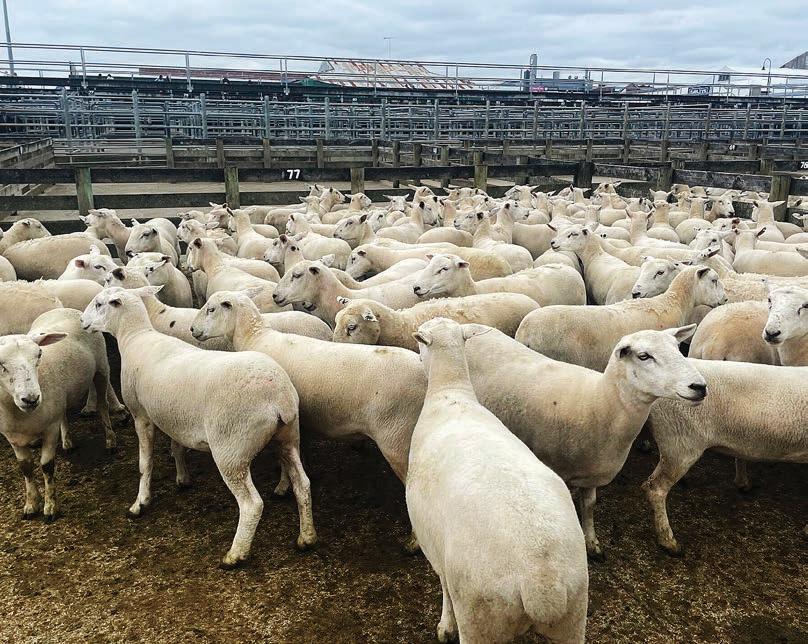
banking inquiry, KiwiSaver access, immigration rules and more,” he says.
“But also for the way he’s built a strong, connected culture within our dairy leadership team.
“I don’t want to reinvent the wheel – I want to build on what he’s done and keep that momentum going, fighting for fairer policy that makes a tangible difference to farmers.”
Karl and wife Amie are 50:50 sharemilkers near Leeston, running a mixed operation that also includes cropping, beef cattle, and Wiltshire sheep.
“Being a dairy farmer, I’m not exactly a great shearer, so the Wiltshires have been a life saver.
“They’re self-shedding – no crutching, no shearing – and fly problems are minimal. They’re a slower-finishing sheep, but they fit well with my farming system.”
As the new dairy chair, Dean wants to make sure the sector stays strong and is ready for what’s next.
“The dairy sector is in a relatively strong position right now. We’ve got decent prices, better immigration settings, and strong competition between milk processors,” he says.
“But it won’t always be smooth sailing – we need to be prepared for future headwinds.”
He’s known for his strong advocacy, not least for his efforts during the prolonged dry spell in North Canterbury.
Dean was named Federated Farmers Advocate of the Year in 2024 for his work publicly calling on councils to delay new regulations until weather conditions improved.
He’s also spent five years on Environment Canterbury’s Biosecurity and Biodiversity Advisory Group, but is now stepping back to focus on his national responsibilities.
“I’ve dropped most of my local roles for now, but I might look at the school board if needed,” he says.
Day-to-day farm management
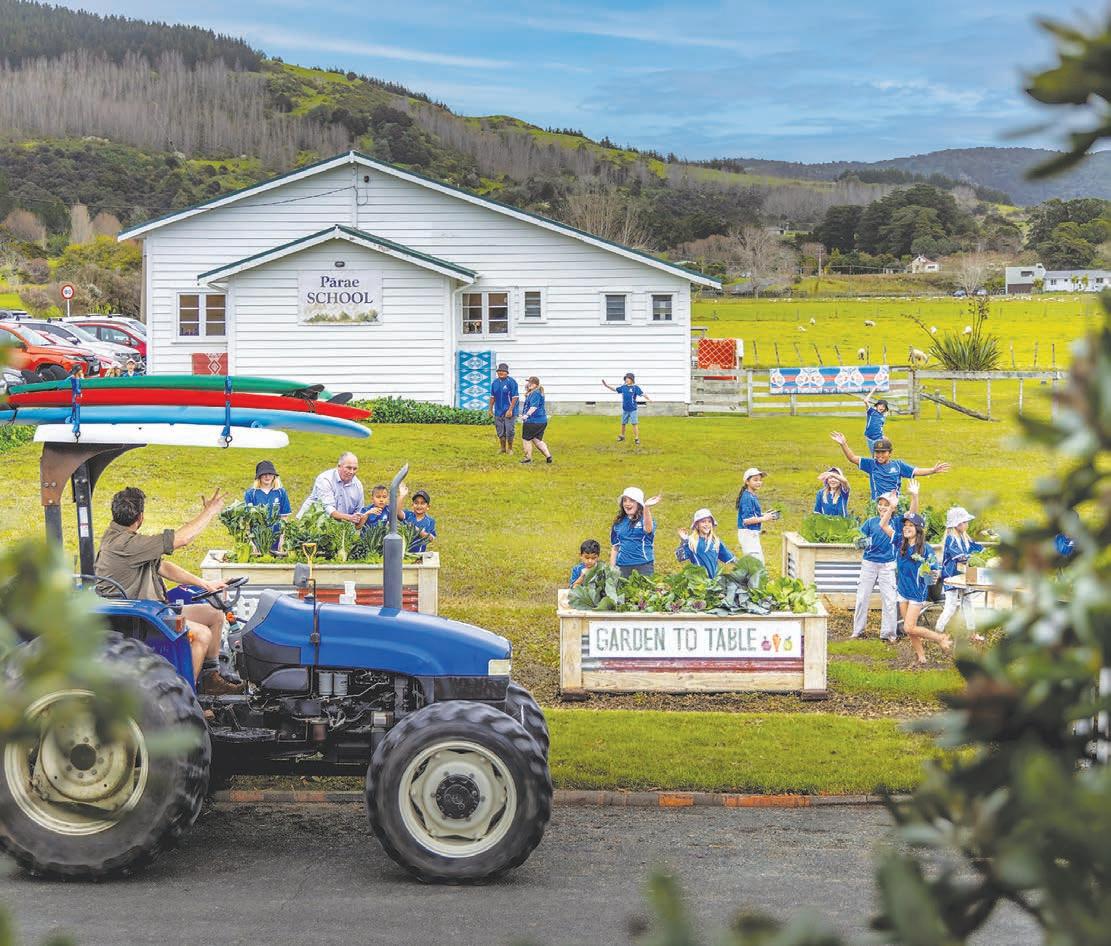
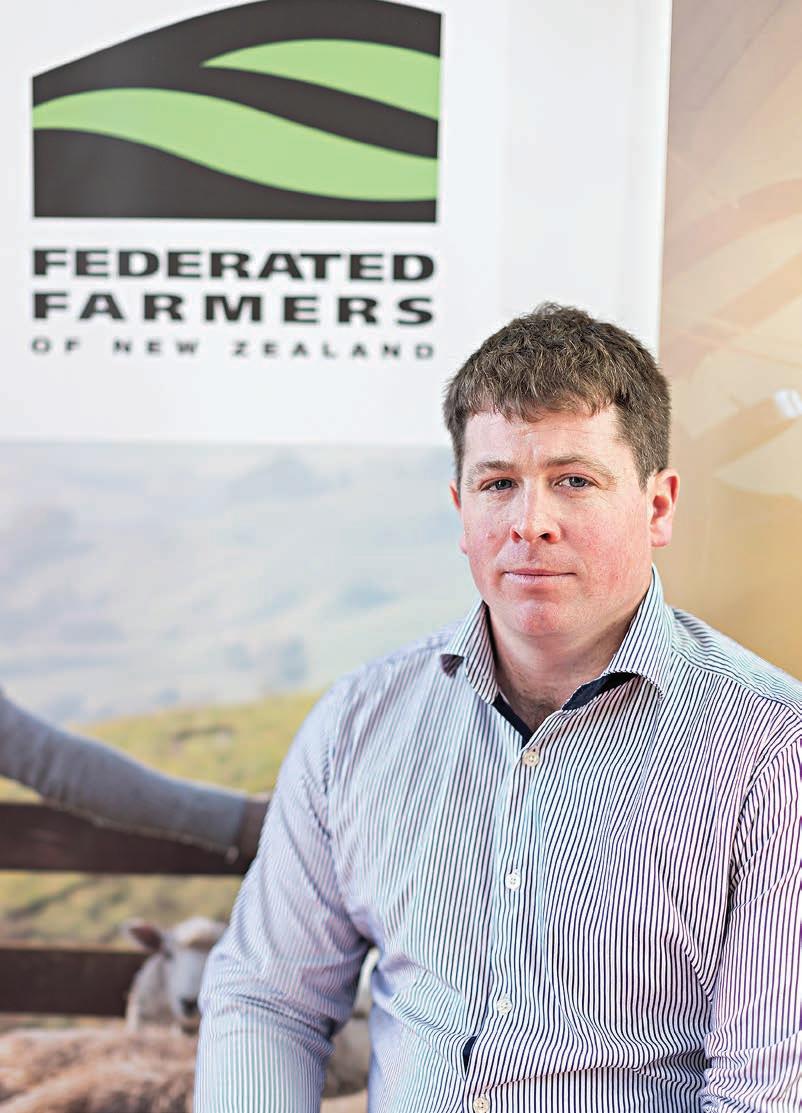
has been handed to a young and capable farm manager, freeing Dean up to focus on the dairy council and strategic parts of the business.
“He’s about 25, has done a DipAg and came through the Grassroots Dairy programme. It’s a great opportunity for him – and it gives me the ability to step back a bit.”
Letting go won’t be easy, Dean admits.
“We’ve been running our own business for 15 years, so it’s a big shift to hand over decision-making. But it’s important to give others the space to grow.”
Outside of farming, his culinary passion remains.
“Cooking and baking is how I relax.
“I don’t talk about it much, but
I mentioned it in a dairy council speech recently and people were surprised,” he laughs.
“Everyone needs something to unwind – mine is baking a chocolate cake or some cookies for the kids. Maybe something savoury too, like a bacon and egg pie.”
Looking ahead to the next three years, Karl has a clear vision.
“I want to know I’ve helped remove some roadblocks for farmers, fought for better policy, and ensured their voices are heard at the highest levels,” he says.
“I want to look back and say we’ve got a strong, connected and empowered dairy council – and that we made life easier for farmers on the ground.”
By suppor ting rural initiatives like Garden to Table, we’re helping to grow vibrant, rural communities
R abobank is New Zealand’s only specialist food and agri bank . So we not only understand farming, we understand the impor tance of strong rural communities
That ’s why we set up the R abo Community Fund to suppor t community-led initiatives like Garden to Table that help our rural communities to grow and thrive To find out more, go to rabobank.co.nz/community
STEPPING UP: New Federated Farmers dairy chair Karl Dean says he plans to build on the momentum created by his predecessor, Richard McIntyre.
MIXED: New Federated Farmers dairy chair Karl Dean runs a mixed operation farm which also includes Wiltshire sheep.
Stand up and be counted, rural NZ
With nominations now open for this year’s council elections, Federated Farmers is urging people who understand farming and rural issues to step forward.
“It’s not just about reining in rampant rates rises – though that’s certainly needed,” the organisation’s local government spokesperson Sandra Faulkner says
“We need level-headed councillors who can make the tough calls locally and advocate nationally for better funding of roads, bridges and other core infrastructure.”
Faulkner says the next three-year term ushers in two major reforms affecting councils: a complete overhaul of resource management laws and a new chapter for three waters services under Local Water Done Well.
“The Government is finally reworking the bloated RMA, which has strangled agriculture and other sectors in endless red tape.
“There’s no doubt the changes are heading in the right direction, but we’ll need councillors who can push back when some council staff inevitably want to keep doing things the old way,” Faulkner says.
Many local authorities are opting for new council-controlled organisations (CCOs) to meet tougher Government standards on drinking water, wastewater and stormwater.
“These CCOs will be run by independent boards with technical expertise, but councillors will still have a vital role,” Faulkner says.
“We need them to challenge any decisions that de-prioritise rural concerns or unfairly shift costs onto farmers for services they don’t benefit from.”
These two reforms will completely change the local government landscape, and NZ First’s Shane Jones is among those suggesting the days of regional councils are numbered.
“Council amalgamations or a
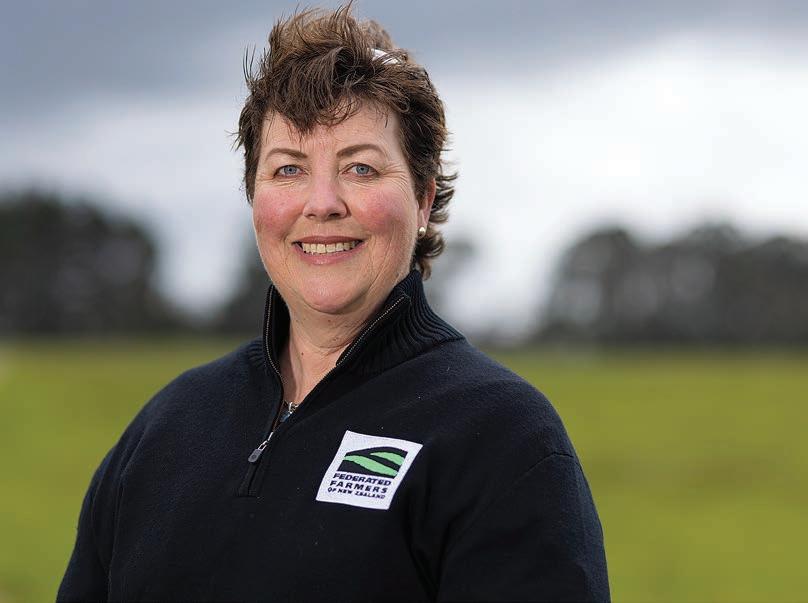
move to unitary councils (combined city/district and regional councils) are worth discussion if they bring genuine cost and efficiency gains,” Faulkner says.
“But whatever the structure, we must make sure the rural voice isn’t drowned out by urban priorities.”
Faulkner, a former Gisborne councillor herself, says it’s pleasing to see so many farmers putting their names forward this year to represent their communities.
We’ll need councillors who can push back when some council staff inevitably want to keep doing things the old way.
Sandra Faulkner Federated Farmers local government spokesperson
In the Horizons region, for example, a strong crop of candidates with rural backgrounds are vying for voter backing.
They include Federated Farmers Whanganui president Ben Fraser,
Sally Dryland – until very recently Tararua’s president – former Whanganui Feds meat and wool chair Peter Wells, Deer NZ’s environmental stewardship manager Luka Jansen, and local farmer Hamish Easton.
Wells, a Tiakitahuna farmer whose long list of credentials includes
chairing local river and drainage committees, has a track record for resisting Horizons’ rates increases – averaging 8.8% for 2025/26 but higher than 20% for some farm and commercial properties.
He’s wary of a council proposal to build – rather than lease – a new office tower.
Federated Farmers has called for any council-led commercial investments costing more than $500 per rateable property should go to a binding referendum.
“Regional councils fly under the radar,” Wells says.
“Most ratepayers don’t even know what they do, so they overlyinterpret legislation, going beyond what national direction requires, to suit their own ideology.”
Wells, who has a civic award for his volunteer work helping to create mountain biking parks and trails, says even community projects like that can get bogged down in red tape.
“One trail that was getting close to a stream took us into a consent process – and fair enough.
“But the hurdles put in front of us, you’d think we were building a new state highway to Woodville.”
Wells says not every farmer has the time or inclination to stand, but there are plenty of ways to help those who do.
“Put up their signs on your property, talk to mates with roadside properties about doing the same, donate to their campaign, turn up at meetings – and most importantly, vote.”
Newly elected Federated Farmers Nelson president Kerry Irvine says he has too much on his plate to stand, but he’s seen the huge advantage of having rural voices around the council table.
“We have a strong relationship with Tasman District Council. The mayor’s a farmer and we have other rural people there too, so our voices and concerns are heard
“As we’ve worked through tricky issues like He Waka Eke Noa and freshwater stuff, it’s such a blessing to have people on council who know how things work on the ground, and who bring a sensible mindset.”
MORE:
Nominations are open until 1 August.
See Federated Farmers: 10 Priorities for Incoming Councillors at www.fedfarm.org.nz
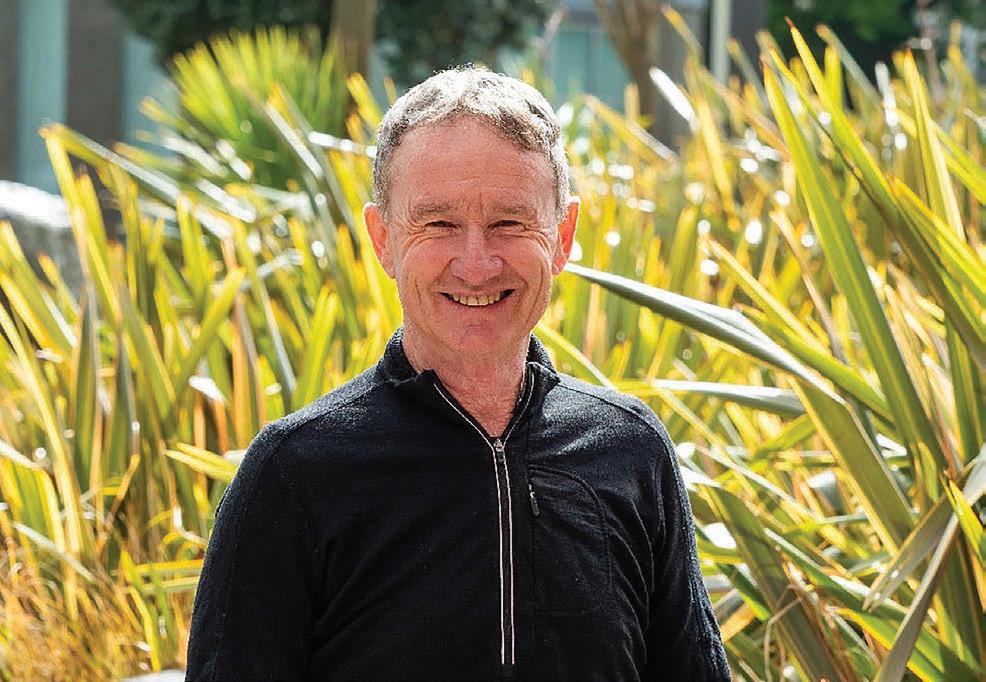
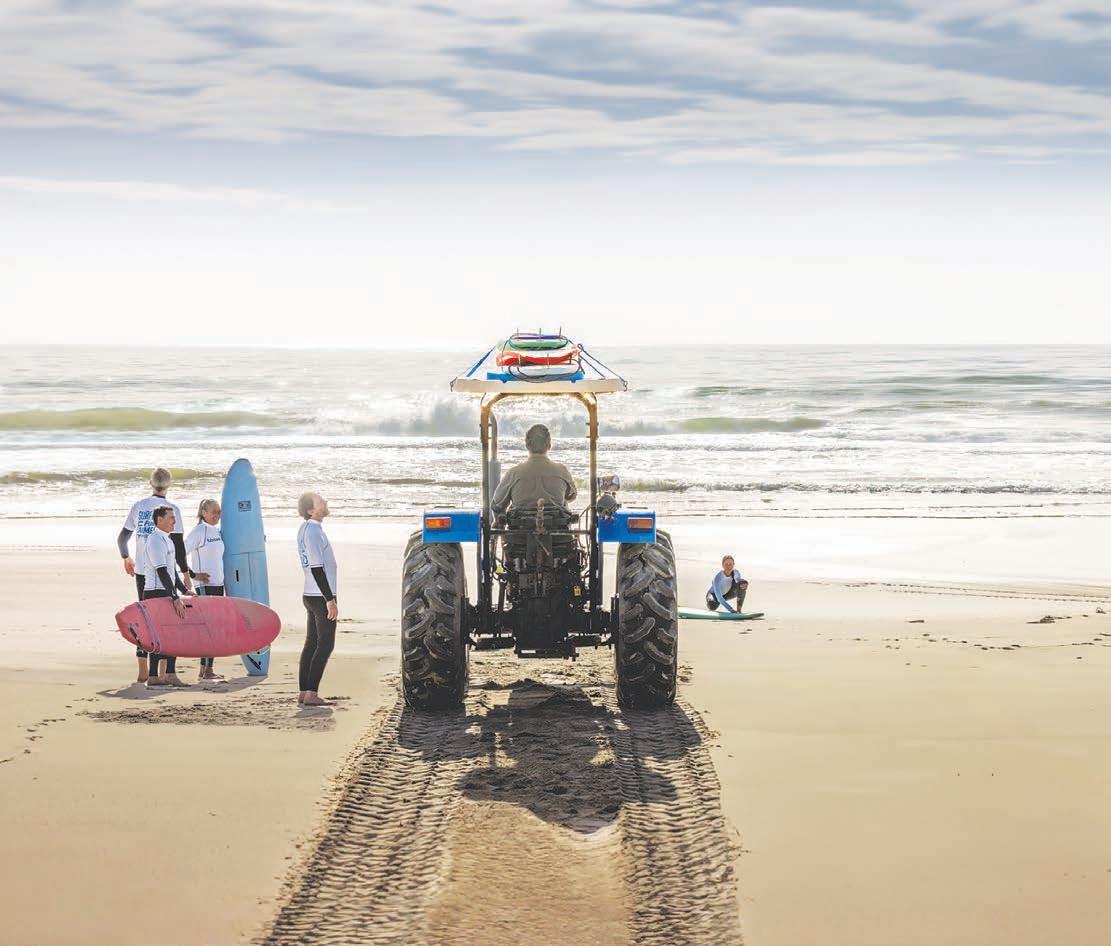
The
Rabo Communit y Fund.
Helping farmers catch a break
.
By suppor ting dozens of rural initiatives like Sur fing for Farmers, we’re helping to grow vibrant rural communities
abobank is New Zealand’s only specialist food and agri bank So we not only understand farming, we understand he impor tance of strong rural communities
hat ’s why we set up the R abo Community Fund to suppor t community-led initiatives like Sur fing for Farmers hat help our rural communities to grow and thrive find out more, go to rabobank.co.nz/community
CHANGE COMING: Sandra Faulkner says rural voices need to be in chambers over the next three years as councils navigate water and RMA reform, with potential amalgamations on the cards.
MOVER: Former Whanganui Feds meat and wool chair Peter Wells is standing for council in the Horizons region. Wells has a civic award for his volunteer work helping to create mountain biking parks and trails.
Photo: Facebook
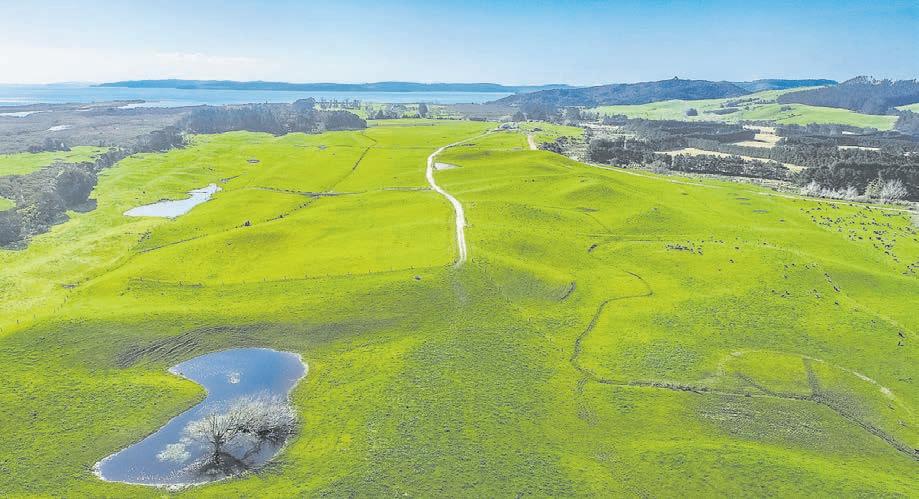
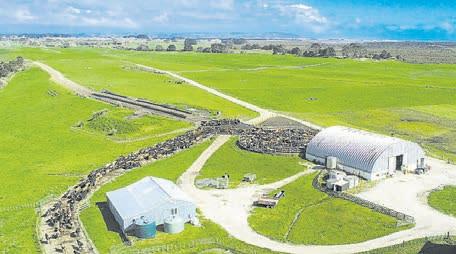
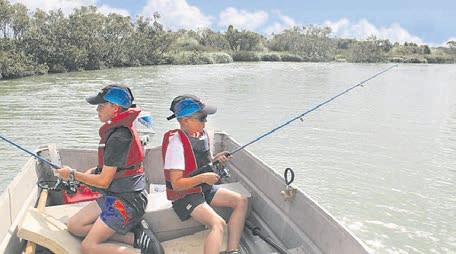
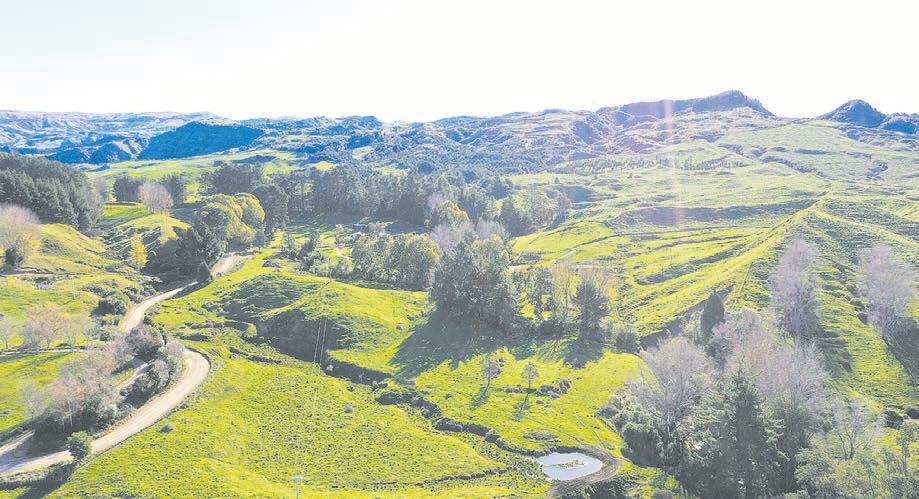
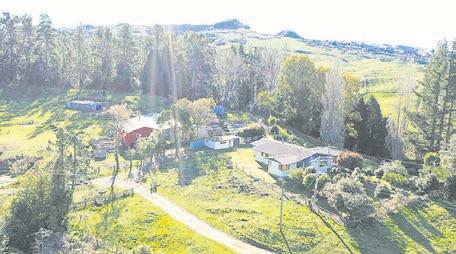
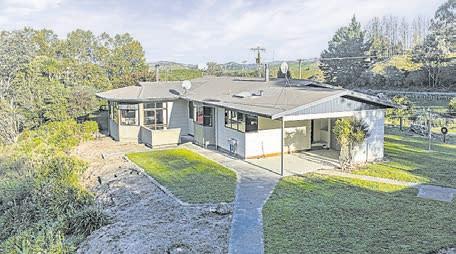
Bulls 200 Beamish Road
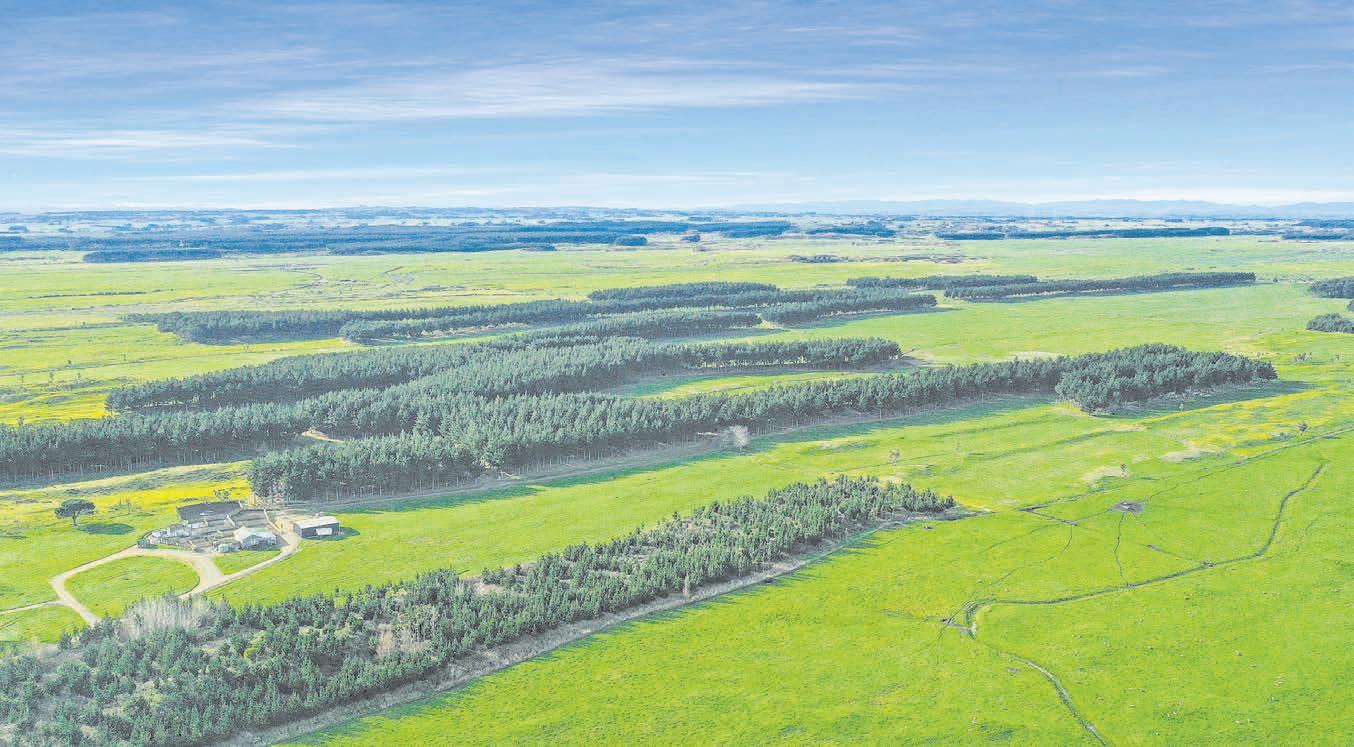
Summer and winter reliable
Tender
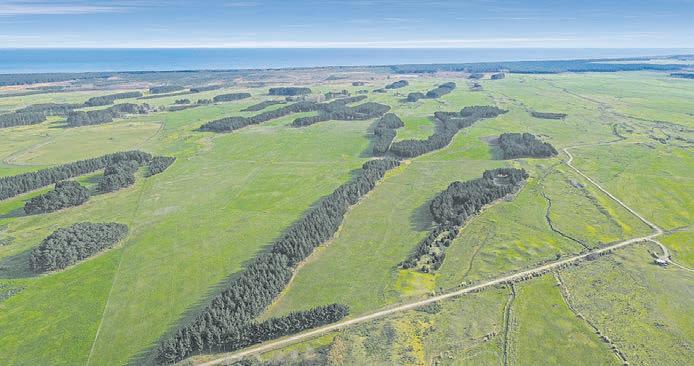
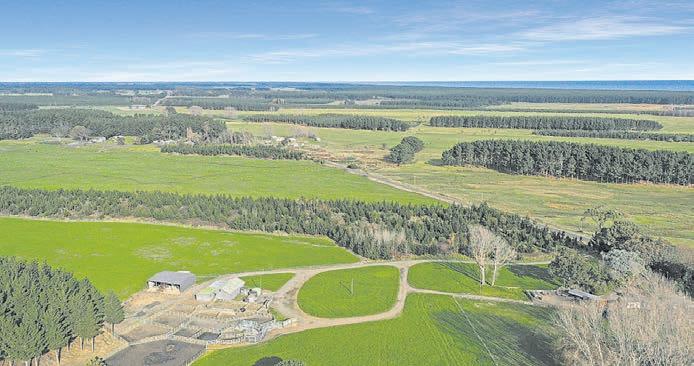
This 232.72 ha property offers exceptional year-round productivity with high feed levels and ideal ground conditions Currently used for breeding, finishing, and support, it’s well-equipped to operate as a standalone unit or complement an existing business. The Pukepuke Black and Himatangi sand soils provide an excellent balance for both summer and winter use. Flat contour with 180 ha mowable 10 ha of dune grazing, and 42 ha of well-maintained pines. Pastures are a mix of modern cultivars and native grasses, supported by regular fertilisation. Infrastructure includes a three-bedroom home, large sheds, woolshed, new stock yards, and a deep bore-fed water system servicing 23 well-fenced paddocks with excellent access.
closes 11.00am, Wed 6th Aug, 2025,


Tapora 392 and 421 Journeys End
Tutira 142 Pohokura Road (subdivision of)
Calf rearing, accommodation, firewood and farming

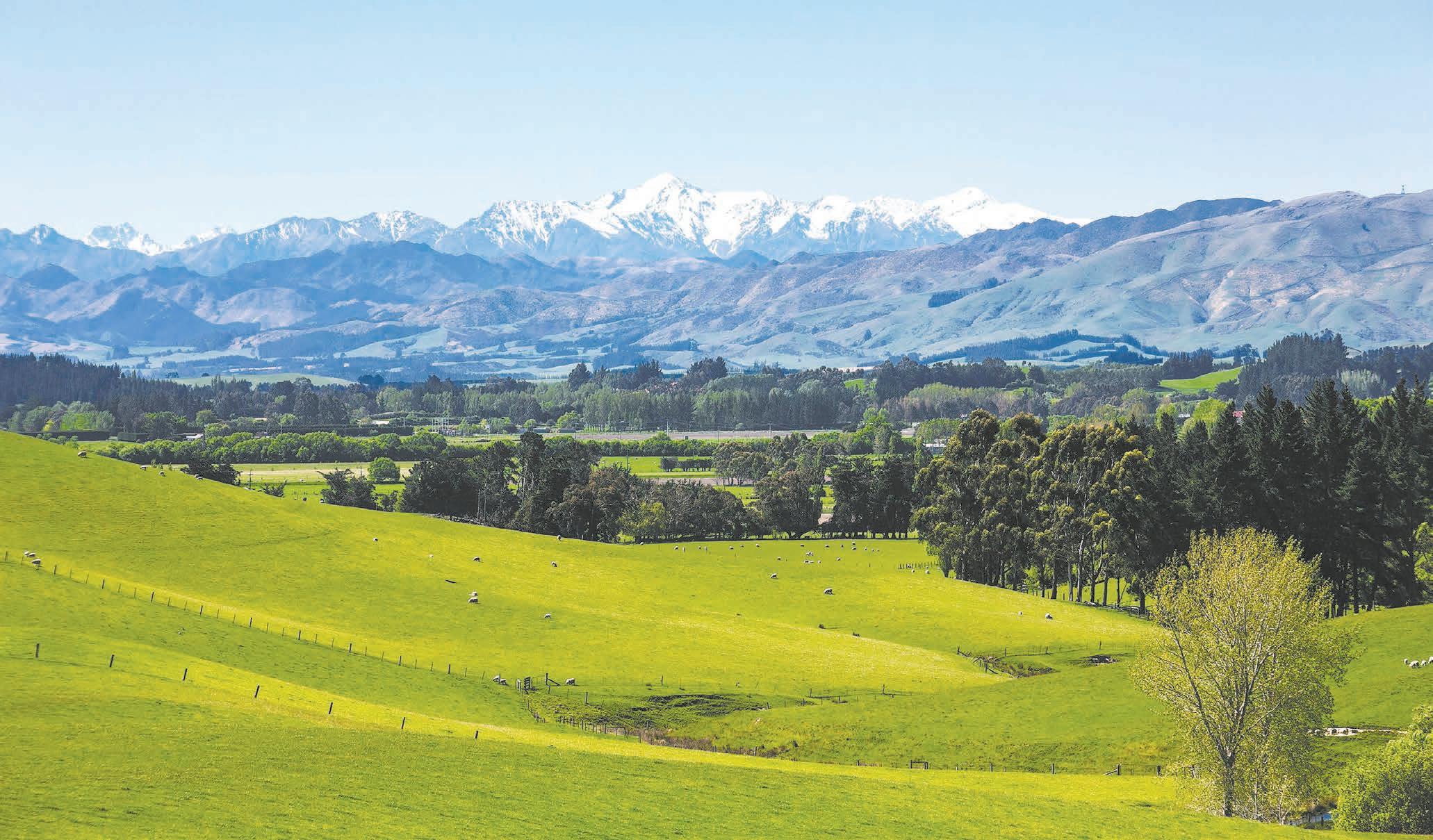
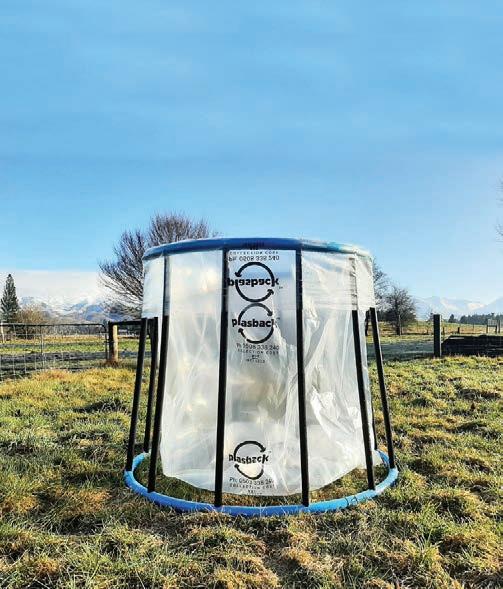

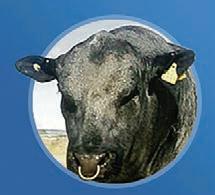
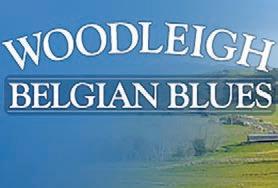
Farm Manager
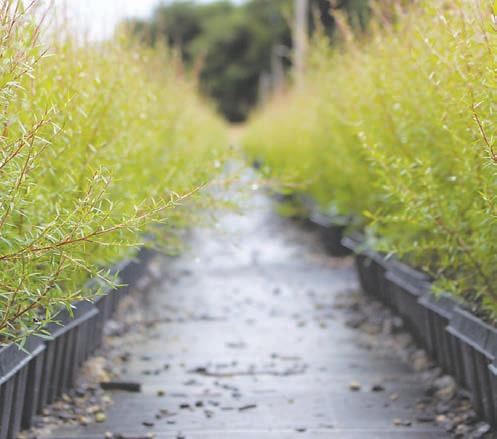
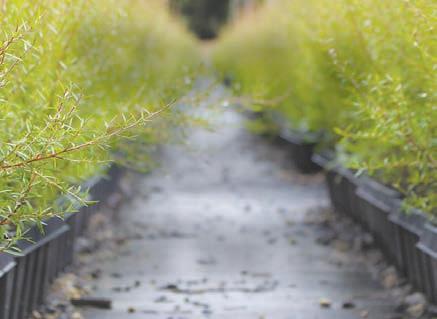


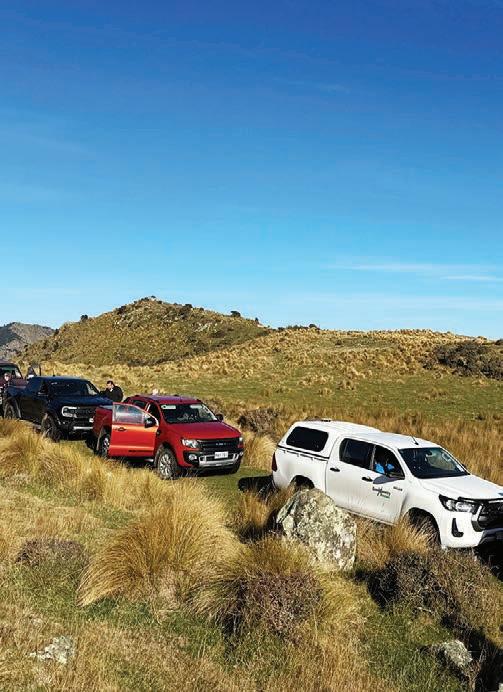

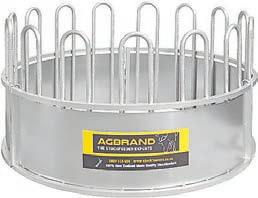
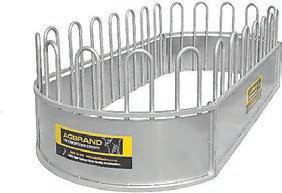













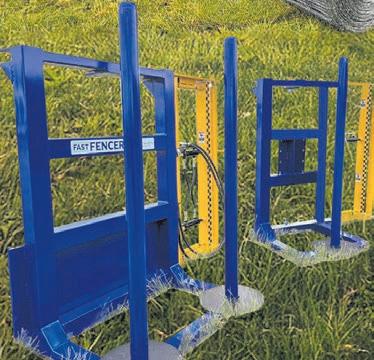
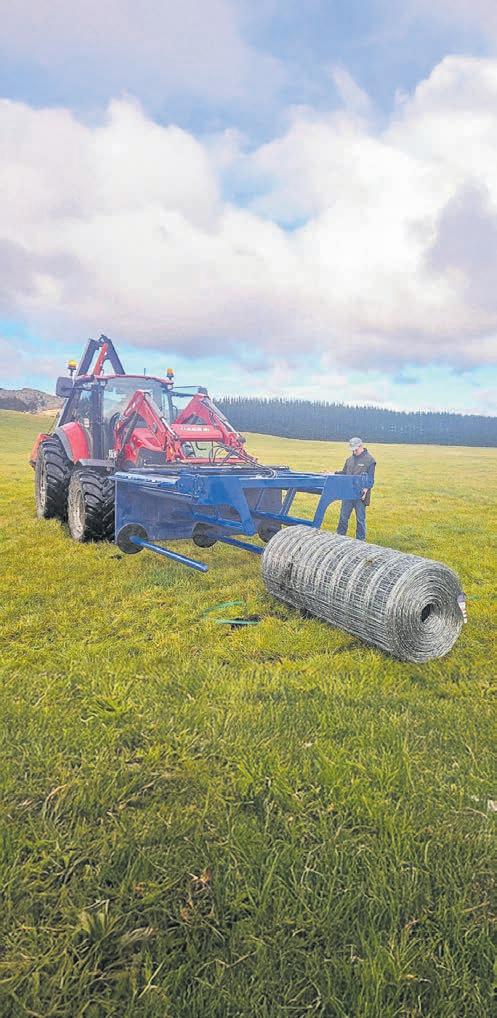


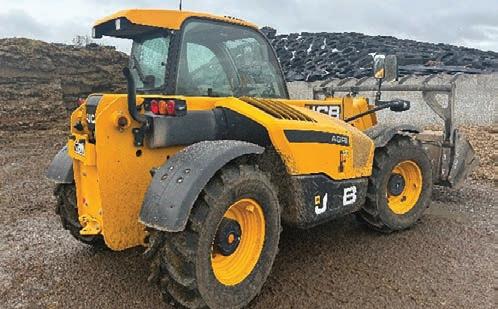
2022 JCB Series 111
538-60 AGRI Telehandler
2000 hours. JCB Q Fit. Max height 6 metres. Max reach 6 metres. Selling with attachments: Allbutt Bucket
Grab 2.4m, Rata Pallett Forks, Rata Hay Fork.
Being Sold Due to Farm Sale
$120,000 + GST
Contact Stephen Barr 027 449 9648 Feilding, Manawatu


BOOK AN AD. For only $3.30 + gst per word you can book a word only ad in Farmers Weekly Classifieds section. Phone 0800 85 25 80 to book in or email wordads@agrihq.co.nz
HORTICULTURE
NZ KELP. FRESH, wild ocean harvested giant kelp. The world’s richest source of natural iodine. Dried and milled for use in agriculture and horticulture. Growth promotant / stock health food. As seen on Country Calendar. Orders to: 03 322 6115 or info@nzkelp.co.nz
LEASE LAND WANTED
FARM WANTED TO LEASE in the Franklin/North Waikato area for Dairy support and drystock. 60ha plus. Phone 027 347 1710.
LIVESTOCK FOR SALE
RED DEVON BULLS. Quality. Well grown. Waimouri Stud Feilding. Phone 027 224 3838.
PERSONAL
SINGLE COUNTRY LADY seeking love/ companionship. A lover of the land and searching for her soulmate. 5 ft 5, 58kgs with long dark hair and blue eyes. Interests include walks, fishing, camping and good old fashioned cooking. Call 0800 315 311 to make contact today.
PUMPS
HIGH PRESSURE WATER

PRACTICAL AND COSTEFFECTIVE farm maps, including an app. No subscription fees. Visit farmmapping.co.nz for a quote.
FORESTRY
WANTED
NATIVE FOREST FOR MILLING also Macrocarpa and Red Gum New Zealand wide. We can arrange permits and plans. Also after milled timber to purchase. NEW ZEALAND NATIVE TIMBER SUPPLIERS (WGTN) LIMITED 027 688 2954 Richard.
GOATS WANTED
FERAL GOATS WANTED. Pick-up within 24 hours. Prices based on works schedule. Phone Vicky Le Feuvre 07 893 8916 or 027 363 2932.
GOATS WANTED. All weights. All breeds. Prompt service. Payment on pick up. My on farm prices will not be beaten. Phone David Hutchings 07 895 8845 or 0274 519 249. Feral goats mustered on a 50/50 share basis.
PUMPS, suitable on high headlifts. Low energy usage for single/3-phase motors, waterwheel and turbine drives. Low maintenance costs and easy to service. Enquiries phone 04 526 4415, email sales@hydra-cell.co.nz
RAMS FOR SALE
WILTSHIRES-ARVIDSON.
Self shearing sheep. No1 for Facial Eczema. David 027 2771 556.
TINY HOME FOR RENT
RURAL CAMBRIDGE. Would suit a retired couple or person. Phone 027 694 4344.
TREES FOR FARMS
ADDITIONAL INCOME. Stock shelter, erosion control, Truffle income, animal fodder, fireproof cork and Natives. 021garden.co.nz Litherland Truffles 021 327 637.
WANTED TO BUY
WHAT’S SITTING IN your barn? Ford, Ferguson, Hitachi, Komatsu, JD. Be it an excavator, loader or tractor, wherever it is in NZ. Don’t let it rust. We may trade in and return you a brand new bucket for your digger or cash for your pocket. Email admin@loaderparts.co.nz or phone Colin 0274 426 936.
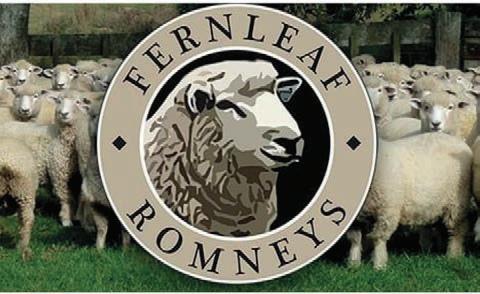
Ross Dyer Clive Bingham WR Dyer Livestock Veterinary Advisor 30 years experience Farm Management Westpac David Galbraith Agri Performance Coach Management to Gold Medalists
Light lunch & beverages provided. Rams available for viewing. Full records available.
3285 Ohura Road, R.D.1, Ohura 3980 Justin 027 656 8782 www.fernleaframs.co.nz

For healthier stock, resistant to worms and facial eczema
SALE TALK
A man wakes up one morning and farts. It sounds like “Honda!”
This puzzles him, so he does it again. “Honda!” He makes an appointment with his doctor to get that checked out. When he demonstrates for the doctor the doctor says “Don’t worry; I’ve seen this before. Go down the hall, three doors to the left and see the dentist.”
“Dentist!” says the man. “This has nothing to do with my teeth!”
The doctor says “Trust me; I’ve seen this before.” So the man goes down the hall and demonstrates for the dentist.
The dentist says that he’s seen this before and asks him to sit in the chair. He pulls a rotten tooth and shows it to the man. “Look, this tooth was rotten.” The man farts again and it sounds perfectly normal!
He says “This is insane. How do you explain this?” The dentist looks him straight in the eye and tells him “Abscess makes the fart go Honda.”


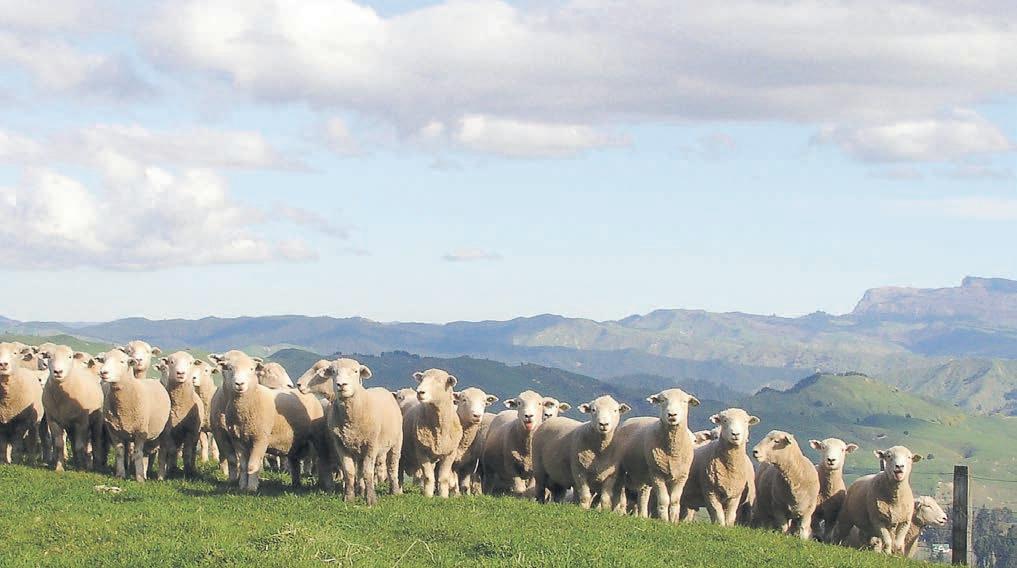

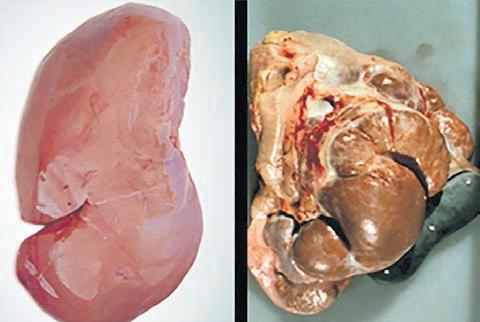


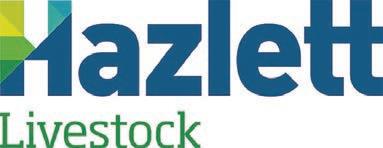
PRELIMINARY NOTICE
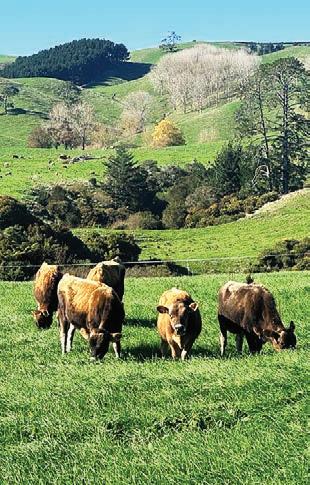


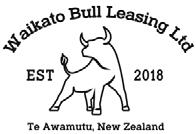




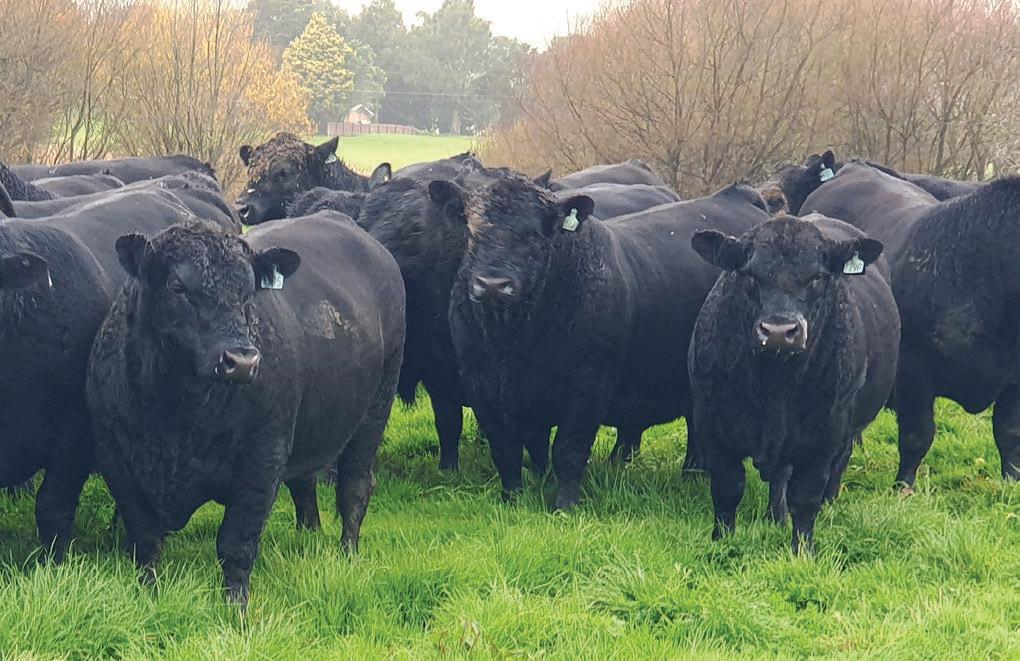


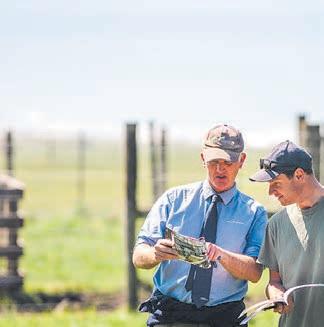
Key: Dair y Cattle Sheep
ther
A record bull sale season to remember

Gerhard Uys MARKETS Livestock
THE recent sale season was one to remember, with sale price records flying out the window, Charolais claiming the highest increase in average prices, and South Devon the highest increase in clearance rates.
The sale record to break all records was set when Tangihau Angus, Gisborne, sold Tangihau U418 for the hefty sum of $161,000.
This record saw an increase of $26,000 against the 2024 highest price of $135,000.
Both records are held by Tangihau Angus.
In the South, Angus also saw their top price increase, up from $70,000 last year to $75,000 for Stern Angus’s Rob Roy of Stern, sold to Cricklewood Angus.
Hereford in the South also set a new top price when Matariki Herefords, Matariki Qualifier Q361, fetched $80,000 to Wilencote Polled Herefords and Mokairau Hereford stud.
This saw Hereford’s highest price increase by a serious $58,000.
This compared to their 2024 highest price of $22,000, in the South Island.
Prior to the new record, Hereford in the North held the record for 19 days with the sale of Kairuru Umaga to Commercial by vendors Kairuru Hereford Stud, Reporoa.
The general manager of NZ Herefords in the North Island, Posy Moody, said it is heartening to see farmers understand that a well-bred bull adds value to both commercial and stud herds. Moody is optimistic about upcoming spring sales and hopes the message is out there that if you want to rear a calf and finish a dairy cross beef animal, you need to select good genetics, which saves you money in the long run.
She said it is clear that the bulls that fetched good prices had good composition but also had good figures behind them, which gave buyers confidence.
Continuing with the top prices, the sale of Lot 1 at $50,000 to Te Pukerakau Herefords and Charolais, saw Hemingford Charolais take back the top spot from Silverstream Charolais.
And for Simmental, the sale of Leafland 230039 at $42,000 to Gold Creek Simmentals saw the Simmental breed take the fourth top spot, moving Simmental’s overall top price from the North Island to the South.
Sales over the previous three years saw Limousin in the North Island sit steady at $9000 with a shift to $11,700 for 2025, achieved by Snake Gully Limousins, Waiotira, Northland.
For Shorthorn, Hinewaka Shorthorns have held the highest price in the North for the 2023 to 2025 seasons, with the sale of Hinewaka Kook 29/23
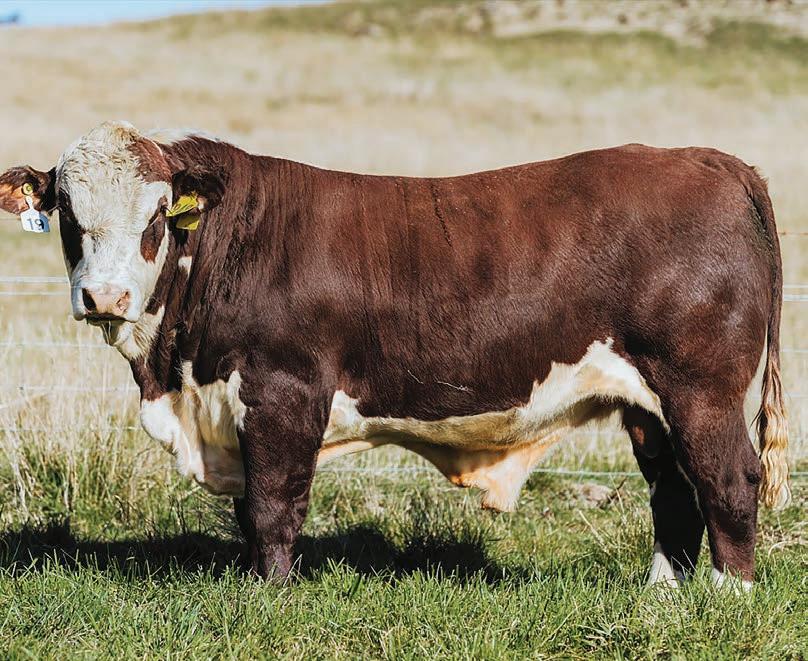
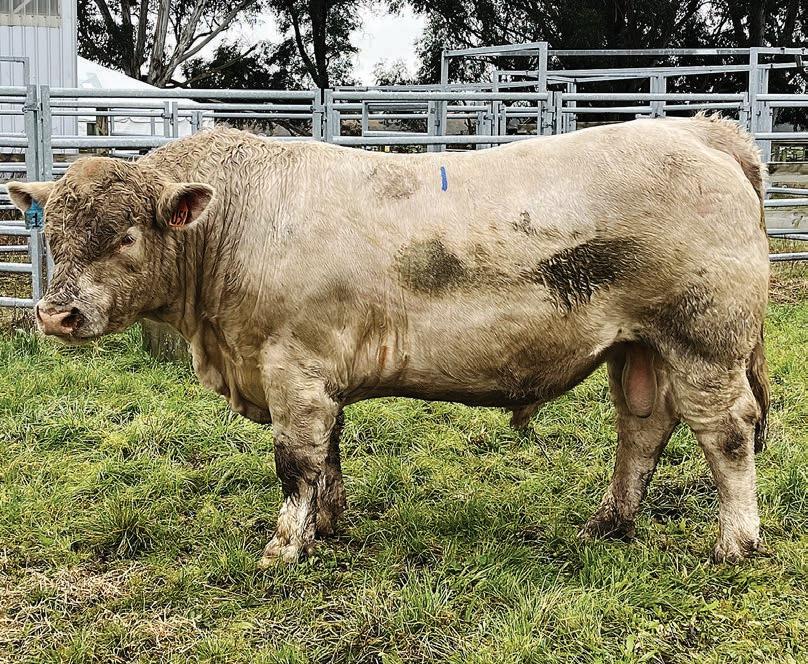
creating a sustainable phase for agriculture, Holland said.
More weight, more money – Charolais deliver that.
Sam Holland Hemingford Charolais
to Glenrossie Beef Shorthorn, increasing Hinewaka’s top price by $3000.
Glendhu Shorthorns have dominated in the South, this season achieving a top price of $12,000.
Moving to the average prices, Charolais have seen the highest increase when comparing 2025 to 2024, resulting in an increase of $3332. This was followed by Hereford at $2704 and then Simmental at $2663.
The Charolais Breeders New Zealand president and owner of Hemingford Charolais in the South Island, Sam Holland, said higher averages for Charolais are partly because more farmers realise they need terminal sires in their breeding programmes.
“More weight, more money –Charolais deliver that,” he said.
He said higher beef prices and the dairy market also played their part.
Good rainfall, farmer positivity and better interest rates are
The highest increase in clearance rates was achieved by the South Devon breed with the percentage sold in the North increasing by 19% to 88%, and in the South increasing by 18% to 92%.
This was followed by Hereford with the percentage sold in the North increasing by 15% to 96% and in the South, increasing 14% to 88%.
Including data this season for the Braford breed we saw Foulden Hill Genetics, Middlemarch, offer two 18-month-old bulls, which sold with an average of $9500, achieving a top price of $10,500 for Lot 19 Bluestone 949, which sold to Dave Andrews at Kyeburn.
For Speckle Park, clearances hit 100% at Maungahina Stud, Masterton. It achieved 12 from 12, an average increase of $2760 and a top price of $13,500.
PGG Wrightson’s national genetics manager, Callum Stewart, said the cents per kilo price for both beef and lamb are high and farmers now have the capacity to invest in good genetics again, in contrast to 12 months ago when investing in quality genetics wasn’t necessarily financially viable.
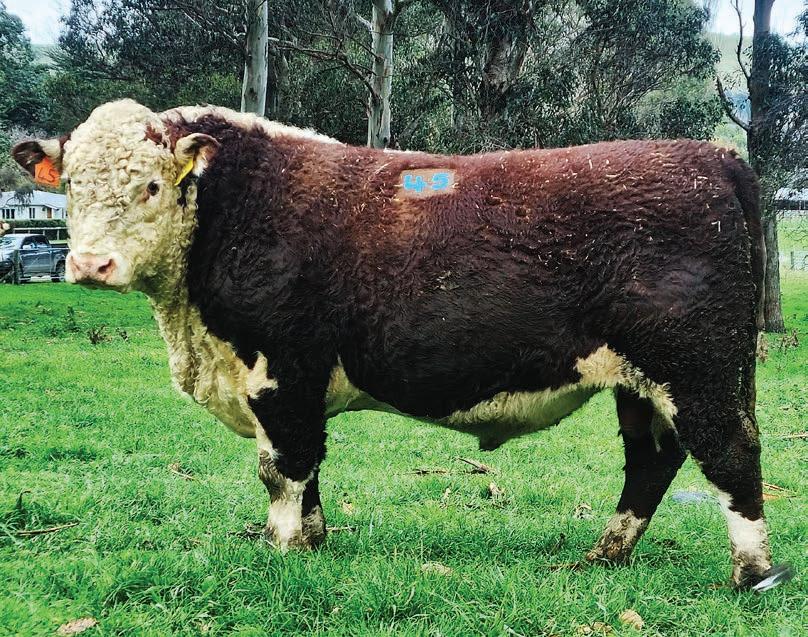
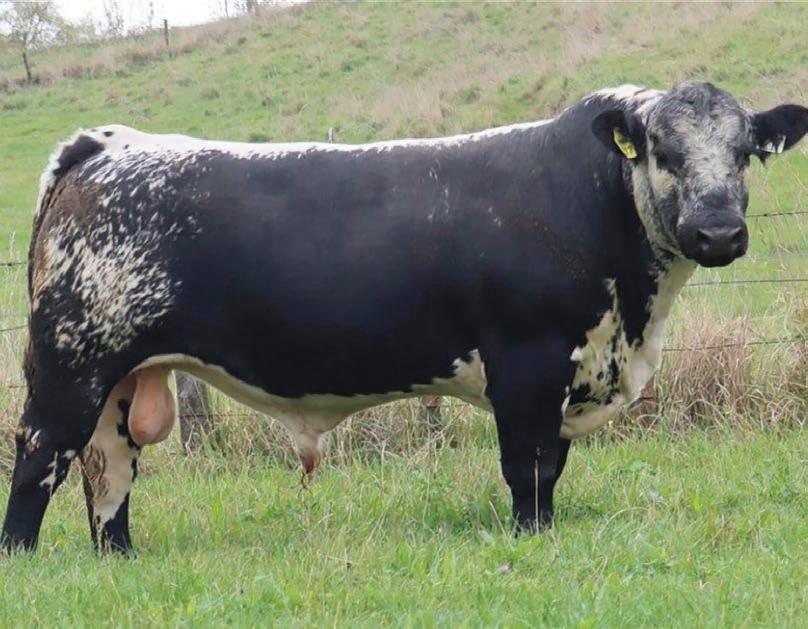
Stewart said his season highlight was seeing averages go to levels never seen before.
Spring season sales are hard to predict, but the way processors looked after their markets will play a key role in shaping the outcome, he said.
Hazlett Livestock South Island stud stock agent Callum Dunnett said this year’s sales attracted some of the biggest crowds he’d seen in years.
In Canterbury clearance rates across breeds were well in the 90 percents, he said.
Farmers understand the value of genetics and its impact on cow herds, and the prices bulls fetched this season show they’re keen to reinvest in their breeding lines, Dunnett said.
Provided store stock numbers remained high, he does not think the spring season will be different, he said.
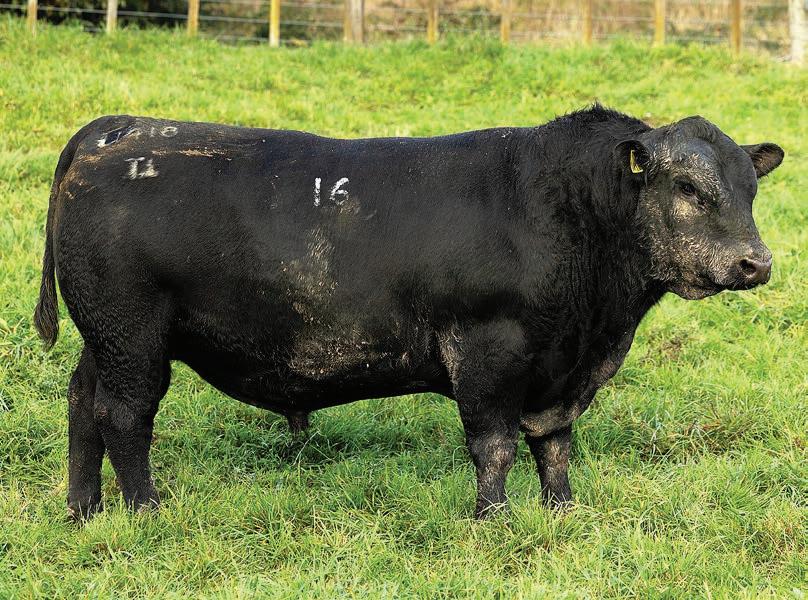
BLUESTONE: Foulden Hill Genetics, Middlemarch, offered two 18-monthold bulls, which sold with an average of $9500, achieving a top price of $10,500 for Lot 19 Bluestone 949 sold to Dave Andrews at Kyeburn.
BREED RECORD: Matariki Herefords, Clarence Valley, made a breed record price of $80,000 for Matariki Qualifier Q361.
PRICE RECORD: Tangihau Angus, Gisborne, set a new Angus bull price record with top bull Lot 16 Tangihau U418 selling for a massive $161,000 to Oregon Angus, Masterton. Photo: Rebecca Williams
UPROAR: For Speckle Park, clearances hit 100% at Maungahina Stud, Masterton. It achieved 12 from 12, an average increase of $2760 and a top price of $13,500. This is Lot 41, Maungahina Uproar U217.
CHAROLAIS: Hemingford Uncharted U50 is the highest priced Charolais bull and overall terminal and sold for $50,000.
Autumn 2025 Bull Sale Review
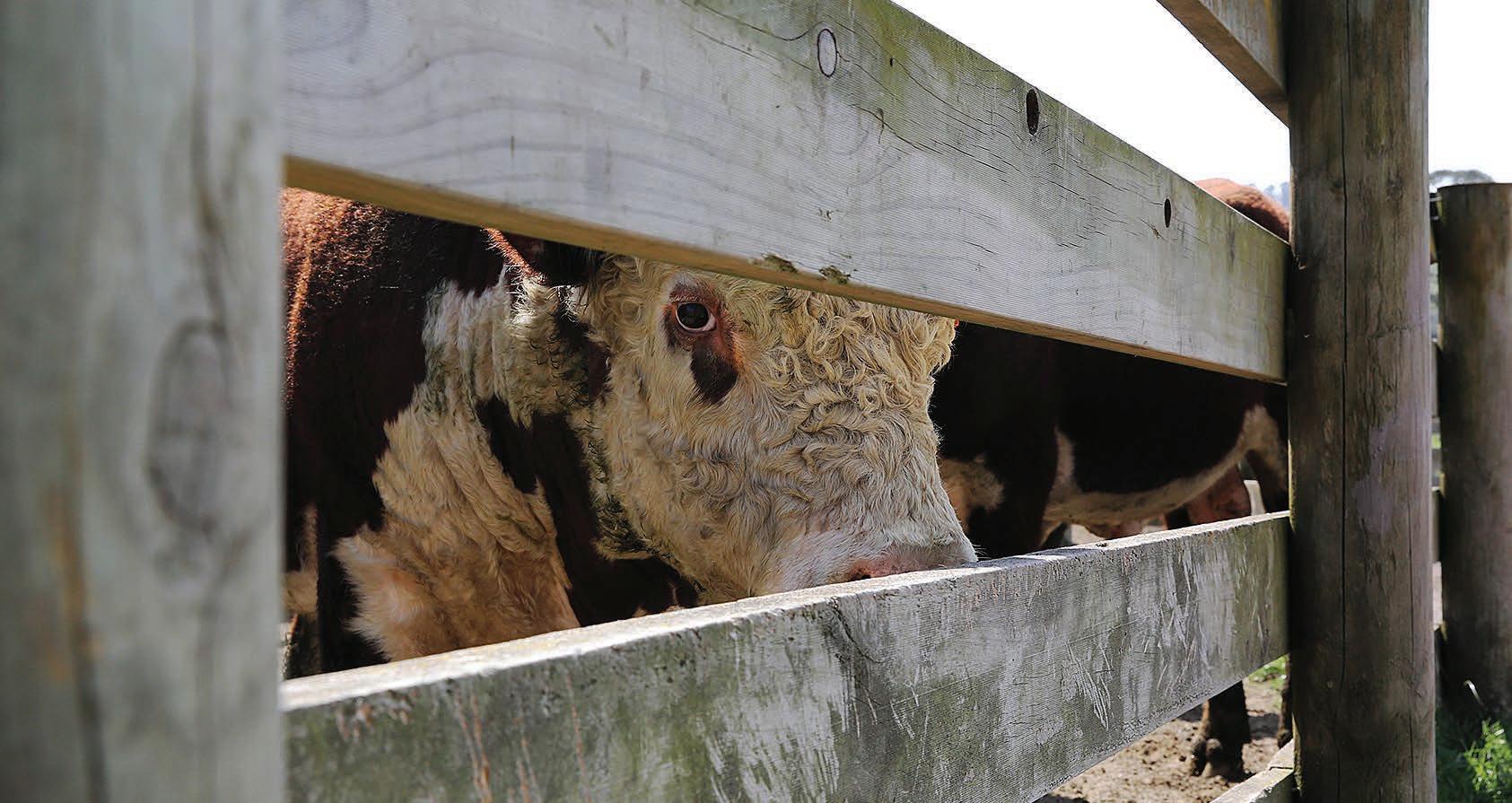

Lamb and cattle markets both bucking the trend
Ceilings are being reached and other limits breached as atypical winter sales play out.
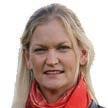
Suz Bremner MARKETS Livestock
NORTH Island winter store lamb and cattle markets are at odds with each other, and both bucking the trend of what is perceived as typical for this time of year.
The store lamb market appears to have hit a ceiling, when it would typically be strengthening as buyers look to secure what old season lambs are left.
The opposite is occurring in the store cattle market, as buyers are pushed further each week into uncharted price territory, and vendors are responding by keeping the cattle flowing into the market.
The store lamb market has been an interesting one to follow this year, given all the hype around prices, which took off as the season unfolded. It does appear, though, that there is only so much fat in the system and, with North Island lamb schedules stabilising for now, store lamb price ceilings may well have been reached. At the Feilding store sale the market firmed through June, aside from the short week when the sale shifted to Thursday and


everyone made the most of the long weekend.
The firm trend would usually continue into July, but there is a feeling that price ceilings may have been hit, and with the quality on offer buttoning off, the market is likely to track along at a steady level, rather than continue to improve.
At Stortford Lodge there is a clear price ceiling in place and prices have levelled out. Volume is expected to do the same with very limited numbers now available from local properties, while Chatham Islands and northern Hawke’s Bay vendors are keeping some trickling into the yards.
With North Island lamb schedules stabilising for now, store lamb price ceilings may well have been reached.
However, new season lamb numbers are growing by the day as lambing gets underway on early country, and the first of these lambs tend to appear at this yard with their mothers from early September and arrive solo from mid-October.
What is interesting to note in the
store lamb market is that these price restrictions are being hit at a time when limited volume is coming forward. Limited volume would usually mean that buyers ramp up the competition to secure stock, but that isn’t the case this year due to the high prices already being paid, as well as the quality of late season lambs.
Feilding saleyards’ volume for June was down on historical levels, coming in at or slightly under the five-year average most weeks. Stortford Lodge levels are well below last year and the five-year average, with a similar pattern at Temuka, and these trends have continued into July. June 2025 was an exceptional month in the R2 cattle pens as vendors reaped the reward of strong competition through early winter. That bucked typical trends for the time of year when the market would usually go into winter mode, but a favourable autumn and healthy budgets created by good margins on finished stock has kept the market pumping along.
At no time in AgriHQ records, which date back to 2008, have all averages for this class of stock been anywhere near the $4/kg mark. However, this year, North Island R2 traditional steers and
Proudly sponsored by

heifers, and dairy-beef steers, have all exceeded that mark, with dairy-beef heifers falling just short.
Averages from data collected at all North Island sales covered by AgriHQ paint an impressive picture for June 2025. R2 traditional steers averaged $1966, $4.34/kg, and dairy-beef steers, $1762, $4.11/kg. R2 traditional heifers averaged $1624, $4.07/ kg and dairy-beef heifers, $1540, $3.91/kg. Compared to five-year averages, the steers were up $580-$610 per head and heifers up $540-$590, with all classes consistently up on $1.25-$1.27/kg on the five-year average.
And vendors have been quick to jump on the band wagon, with tallies for most of these classes up on previous years.
Though it is still early days for July, that trend has continued. At time of going to print, North Island R2 traditional steers were averaging $4.59/kg and dairy-beef, $4.22/kg.
R2 traditional heifers were limited in number but averaging $4.17/kg and dairy-beef heifers have cracked the $4/kg mark at $4.01/kg.
But the question will be, will there be the usual grass market lift in August/September or, like the lambs, is it already at its ceiling?
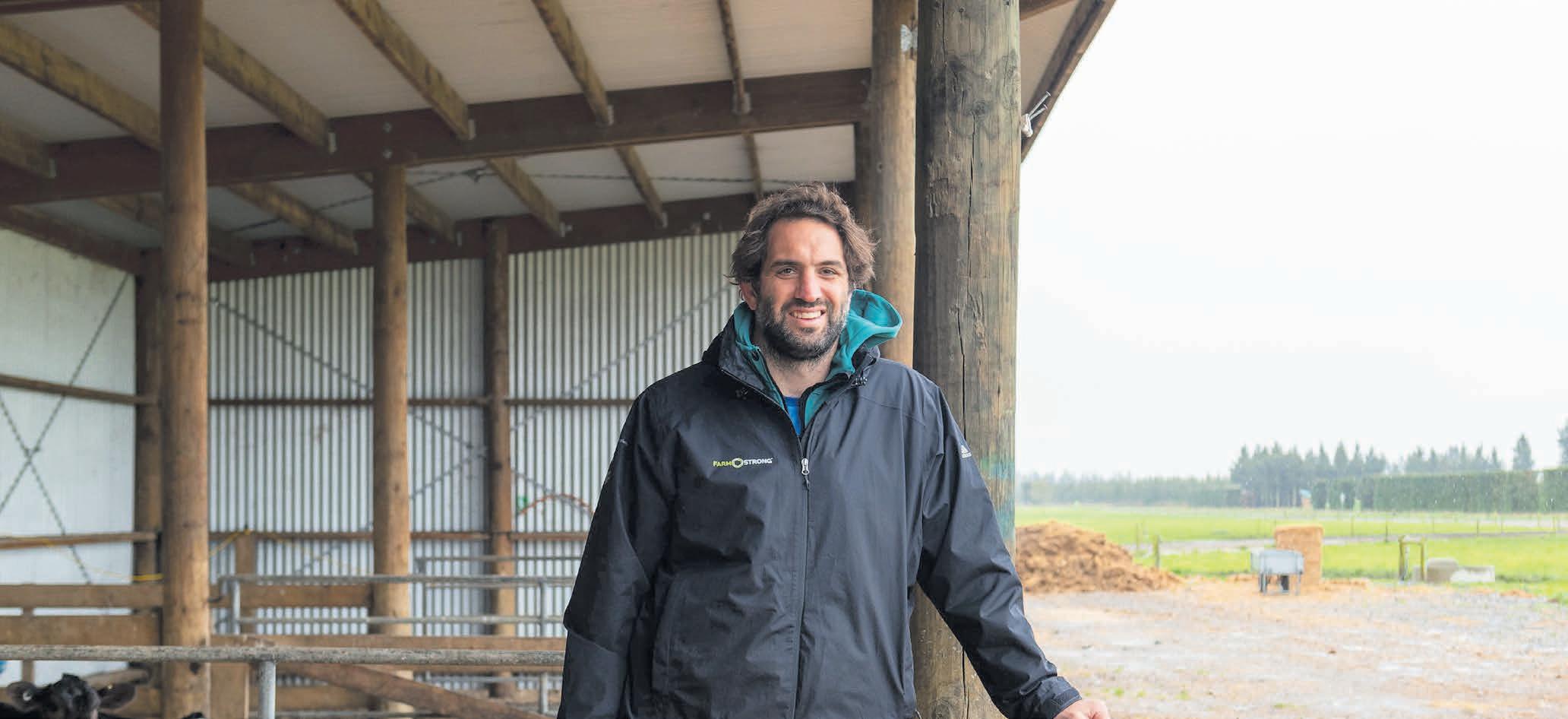



Sam Whitelock Farmstrong Ambassador

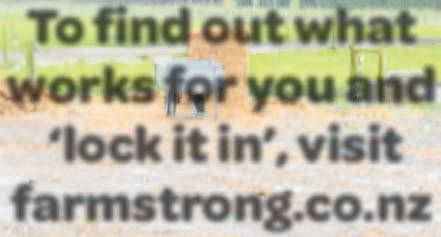
PLENTY OF STEAM: Cold winter mornings are creating steam at yards around the country, but so too are the winter store cattle prices. This line of R2 Angus steers sold for $2430, $4.51/kg at Stortford Lodge on Wednesday, July 9.
Cattle Sheep Deer

Weekly saleyard results
These weekly saleyard results are collated by the AgriHQ LivestockEye team. Cattle weights and prices are averages and sheep prices are ranges. For more detailed results and analysis subscribe to your selection of LivestockEye reports. Scan the QR code or visit www.agrihq.co.nz/livestock-reports
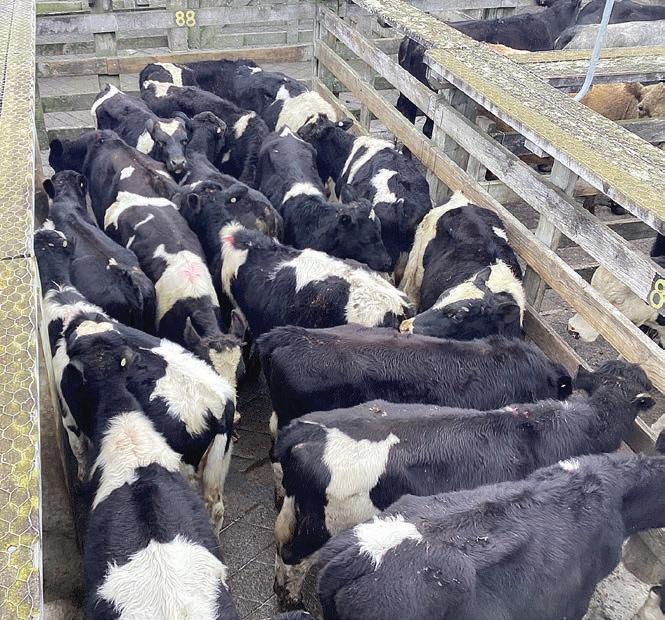
A RARE TREAT: This pen of R1 Friesian bulls attracted strong competition at Stortford Lodge on Wednesday, July 9. They averaged 221kg and made $1215, $5.50/kg.
Rongotea |
Coalgate | July 3 |
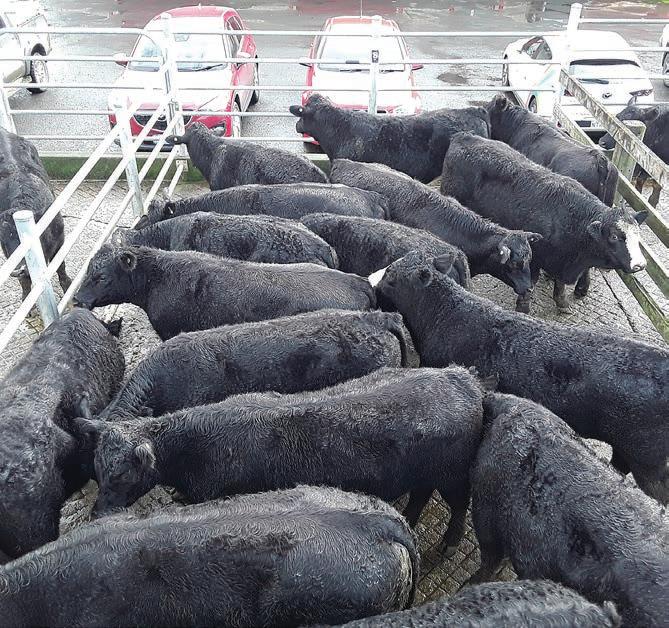
Canterbury Park | July 8 | 282 cattle, 1921 sheep
ewes, most
lambs, most
Temuka | July 7 |
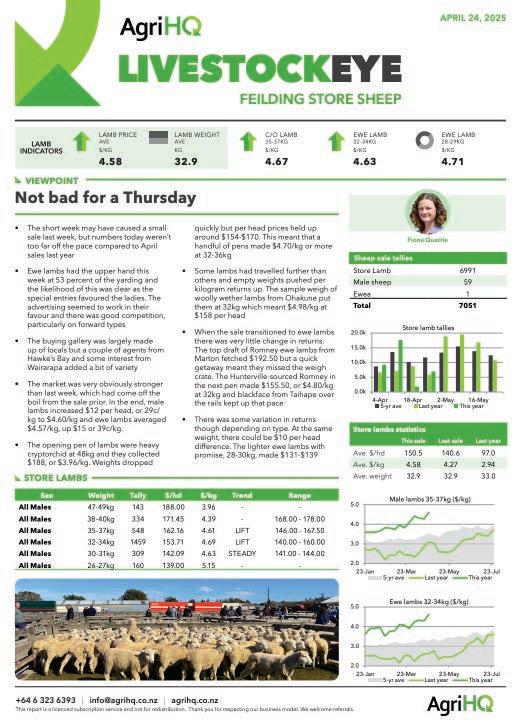

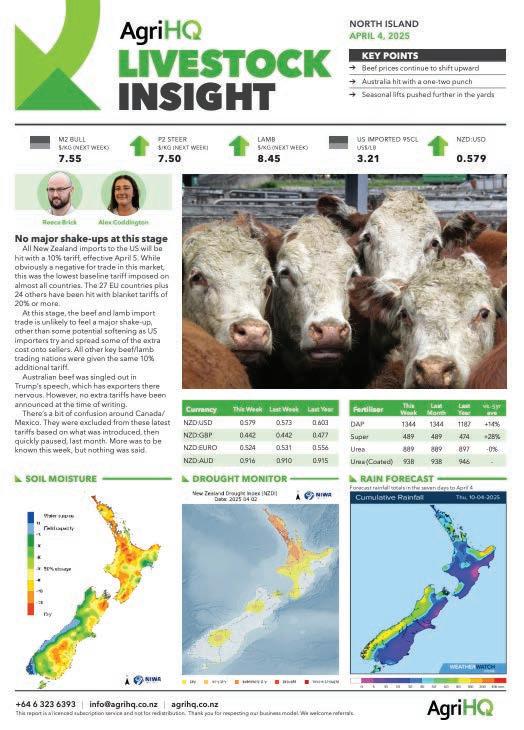
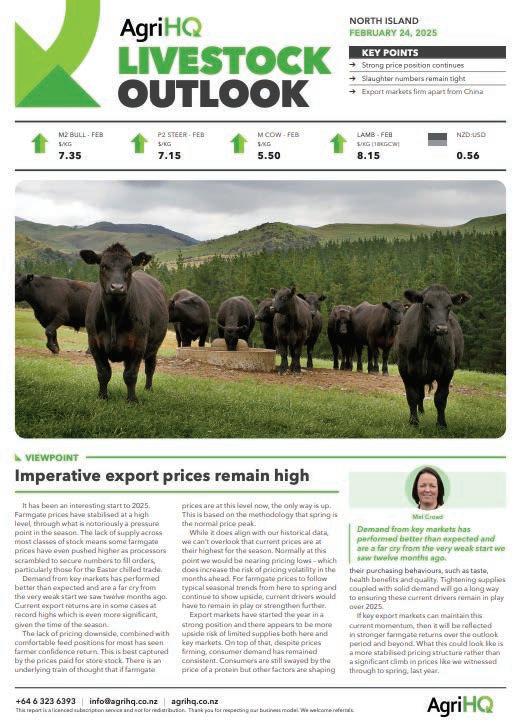

Westerly flow brings western lows

Philip Duncan NEWS Weather
LOW pressure south of New Zealand is expanding and for the next couple of weeks basically covers the entire area between Antarctica and southern Australia and NZ.
High-pressure belts have, for the most part, shifted north of New Zealand (although some do still appear south of our country at times too, but most of them are well north of us).
These northern highs, along with all the southern lows, create a belt of westerly winds from southeastern Australia into New Zealand.
For the next two weeks the NZ area is dominated by this westerly flow, which at times surges milder north-west and at other times becomes colder with a southerly lean to it.
Over the next week or two there are several cold fronts coming into the country from the west.
Over the next couple of weeks there are several low pressure systems crossing NZ, coming from west of NZ or south-west of us. From what I can see at the time of writing this there were no high pressure zones expected to be centred over NZ for the next couple of weeks – although some may briefly brush us.
This set-up encourages the bulk of the rain to fall where we would expect it to – Westland and Fiordland. Much of the incoming rain is westerly focused for both main islands.
When you look at the 16-day rainfall map attached (which covers the heavy rain that just fell over the weekend and Friday) it shows a very typical westerly set-up for New Zealand. Fiordland and Westland have over 300mm on the way.
The western top of the South Island has 200mm. Taranaki to Waitomo area has 100 to 150mm coming up, while the top of the North Island has 80 to 100mm generally coming (and remember some of that has fallen over this past weekend).
But eastern NZ, as most of you know, doesn’t get much rain out of a westerly airflow.
Lowest rainfall totals over the coming week or more will be in Hawke’s Bay, Wairarapa, parts of Canterbury and Otago too. In Hawke’s Bay upcoming rainfall may be as low as just 5mm.
As we head towards the end of July there may be some southern high pressure coming back into focus – but for now there’s a lot of low pressure on the way.
The westerly flow also limits how much snow NZ’s mountains will get. While the Southern Alps do have some snowy chances off and on over the rest of this month, it may not be a lot for everywhere – especially
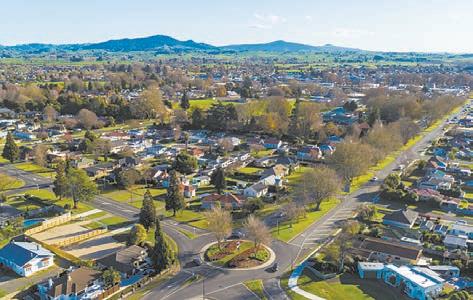
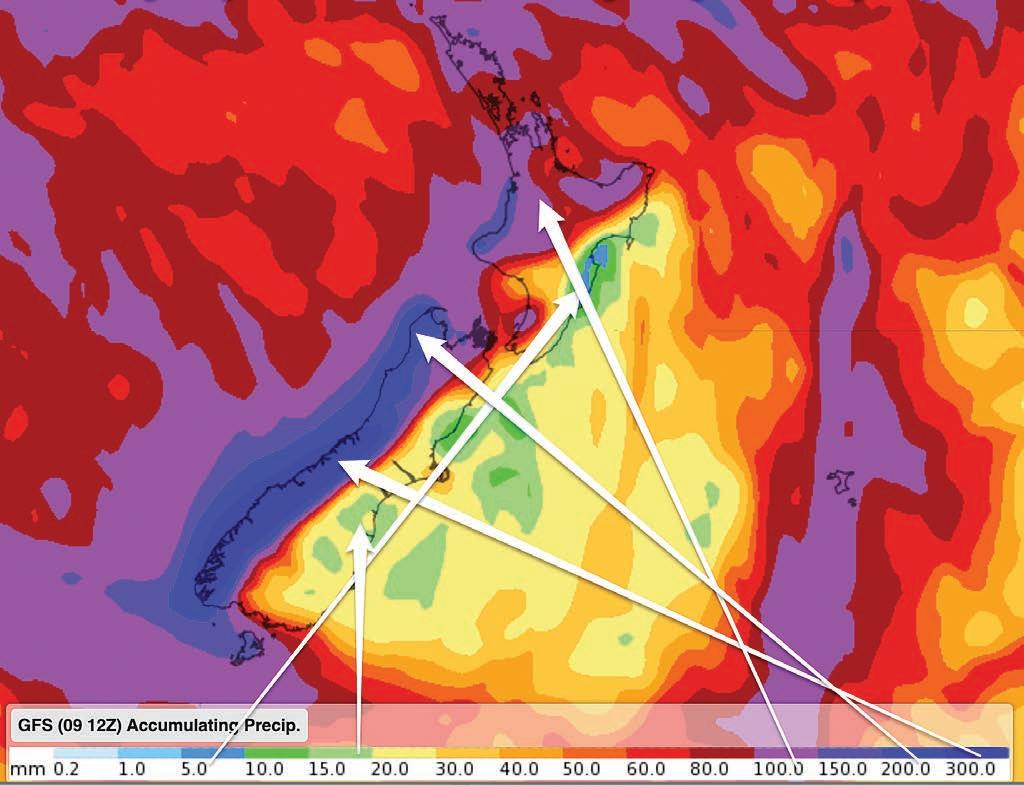
16 Day Expected Rainfall to July 26 (from July 10)
along the eastern side. North Islanders look to have fewer snow events in the mix too. There are limited frosts in the forecast as well – but again, they don’t appear overly heavy in most places, thanks to the
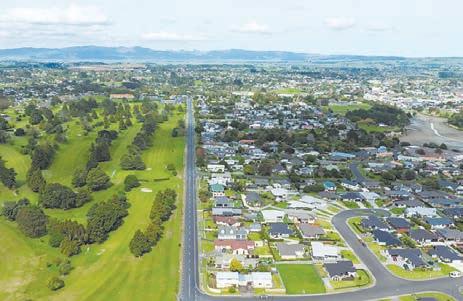
westerlies, cloud and wet weather that are also all in the mix.
We may be technically going into the depths of winter – but the forecast isn’t as wintry as it could be for everyone.
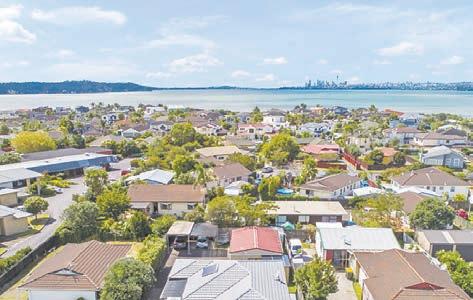

INCOMING: This 16-day rainfall map shows most of the incoming rain is coming from the west.
